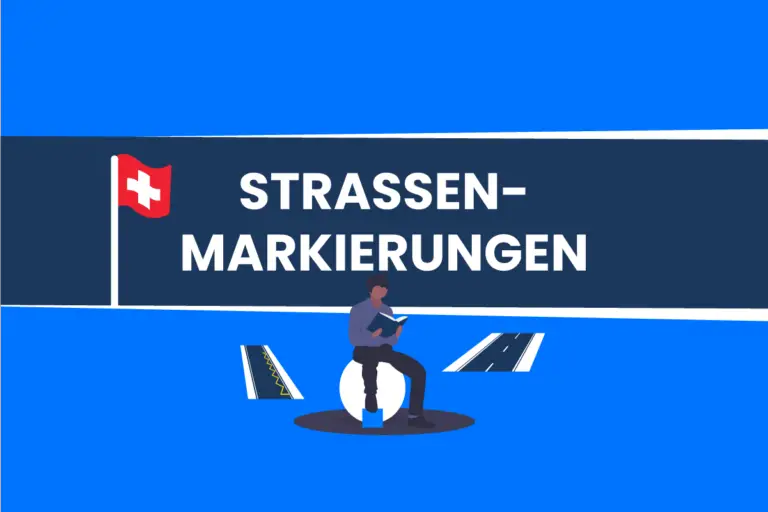No Stopping With Additional Signs In Germany Explained
No stopping (traffic sign 283) is combined with various additional signs. Sometimes it’s difficult to keep track. What does No stopping mean, and how do additional signs change the meaning of No stopping?
Traffic Sign 283 prohibits stopping on the road. No stopping can be limited in time or to certain types of vehicles with additional signs or extended to hard shoulders.
This article shows you which additional signs are combined with No stopping and what meaning they have. In addition, the following questions are answered:
- What are hard shoulders?
- How is No stopping restricted to specific times or days of the week?
- How is No stopping limited to cars, mobile homes or buses?
- Can certain groups of people or types of vehicles be exempted from No stopping?
- And many more …
Here we go!
No Stopping: Also On Hard Shoulder
No stopping (traffic sign 283) without additional signs only apply on the roadway (Annex 2 consecutive number 62 StVO).
Stopping on the roadway is prohibited.
Annex 2 consecutive number 62 StVO
What is the meaning of the combination of No stopping and an additional sign showing a crossed-out car on a white horizontal bar?
If No stopping is set up together with the additional sign 1060-31 (Haltverbot auch auf dem Seitenstreifen), stopping on the roadway and on the hard shoulder is prohibited.
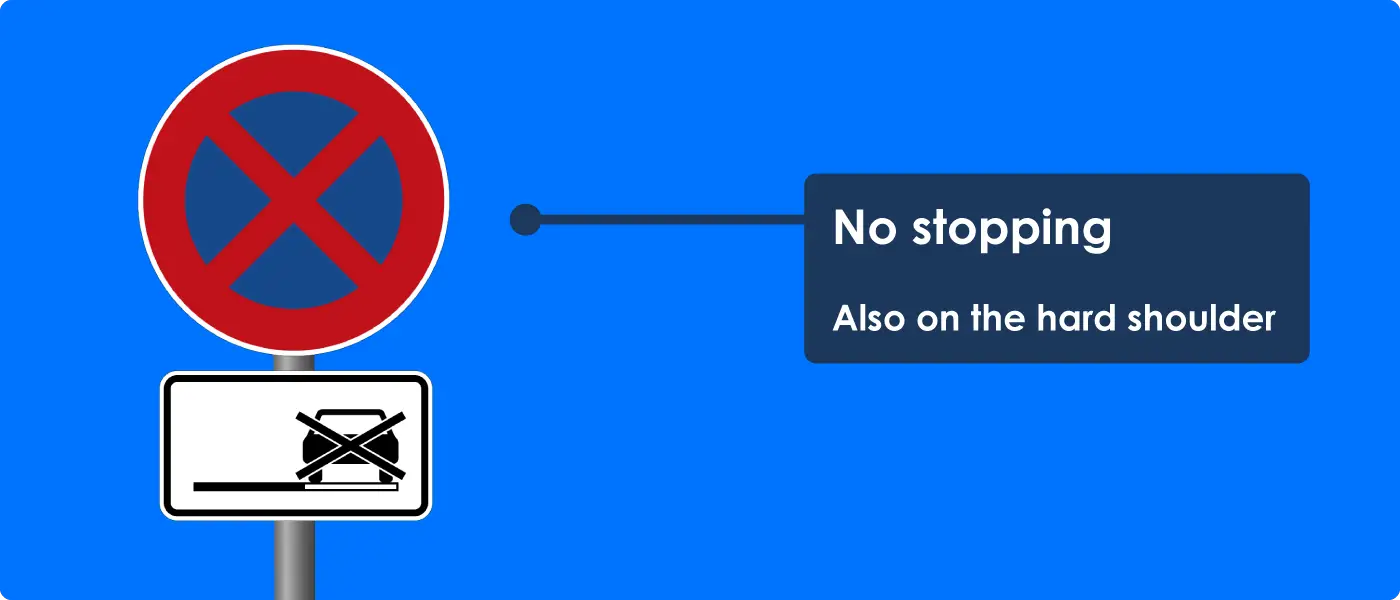
The additional sign arranged with traffic sign 283 also prohibits vehicles from stopping on the hard shoulder (Annex 2 consecutive number 62.1 StVO).
In practice, No stopping with the additional sign “No stopping on hard shoulder as well” on the right-hand side of the road looks like this:
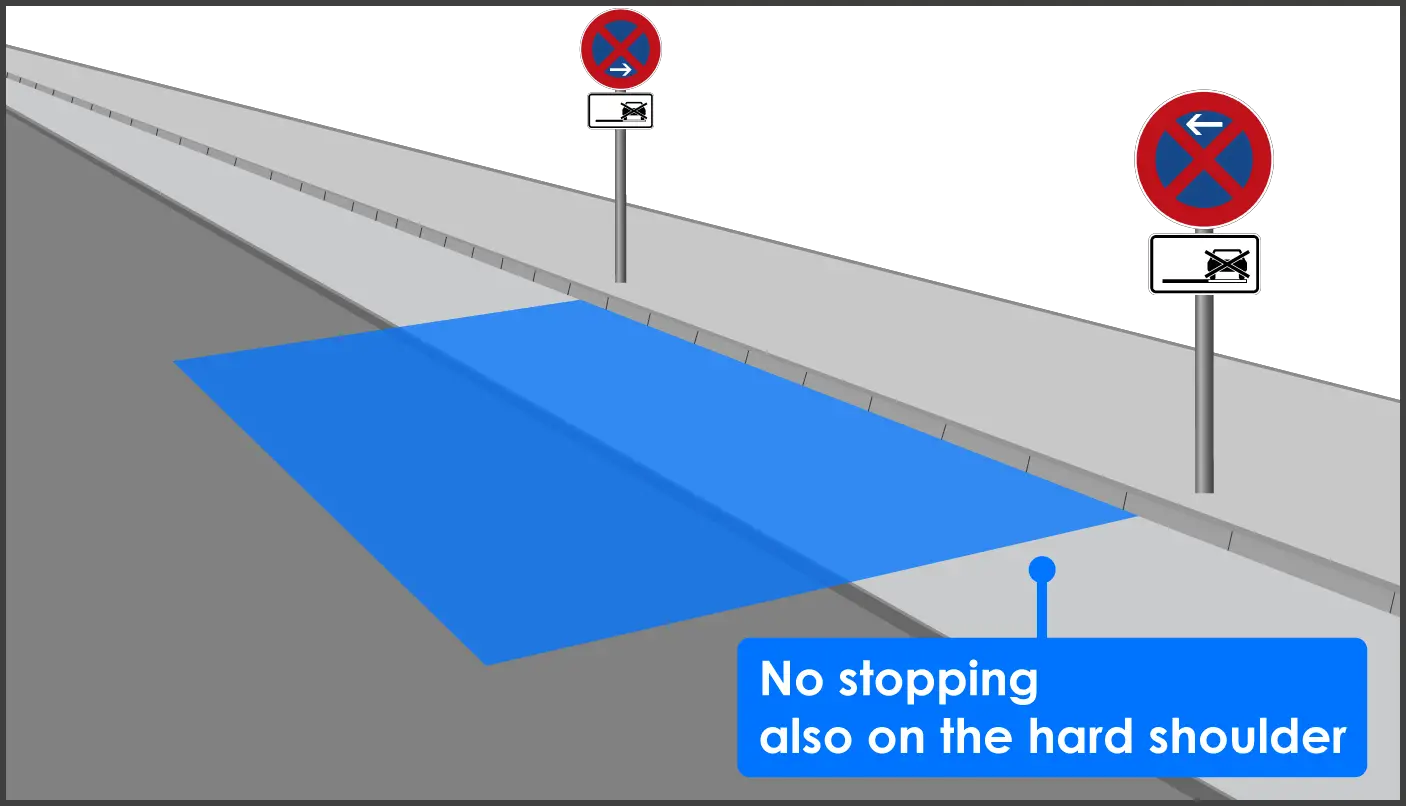
What is meant by a hard shoulder?
Hard shoulders are not part of the road (section 2, paragraph 1 StVO).
According to the General Administrative Regulation on Road Traffic Regulations (VwV-StVO), a hard shoulder is the part of the road that is situated directly next to the roadway (VwV-StVO on section 2, paragraph 4 sentence 5).
Hard shoulders can be paved or unpaved (VwV-StVO on section 2, paragraph 4 sentence 5).
Hard shoulders also include paved parking lanes along the roadway (section 12, paragraph 4 StVO).
Hard shoulders are part of public roads (Burmann/Heß/Hühnermann/Jahnke, Straßenverkehrsrecht, 26th edition 2020, marginal numbers 13 on section 1 StVO).
No Stopping: Only On Hard Shoulder
What does No stopping with the additional sign with the inscription “auf dem Seitenstreifen” prescribe?
If No stopping is set up together with the additional sign 1053-34 (auf dem Seitenstreifen), stopping on the hard shoulder is prohibited. However, stopping on the roadway is permitted.

The additional sign arranged with traffic sign 283 prohibits vehicles from stopping only on the hard shoulder (Annex 2, consecutive number 62.2 StVO).

No Stopping: Time
Additional signs under No stopping can contain general restrictions (section 41, paragraph 2 StVO).
In fact, No stopping may only be set up to the extent required by local circumstances (VwV-StVO on traffic sign 283).
Local circumstances include
- road safety,
- the fluidity of traffic and
- local public transport (VwV-StVO on traffic sign 283).
Before setting up No stopping, the Road Traffic Authority must check whether it is possible to limit the No stopping to a specific time of the day or a specific time of the week (VwV-StVO on traffic sign 283).
No stopping can be limited to a period of time with additional signs.
For example, No stopping shown below is valid from 4 pm to 6 pm
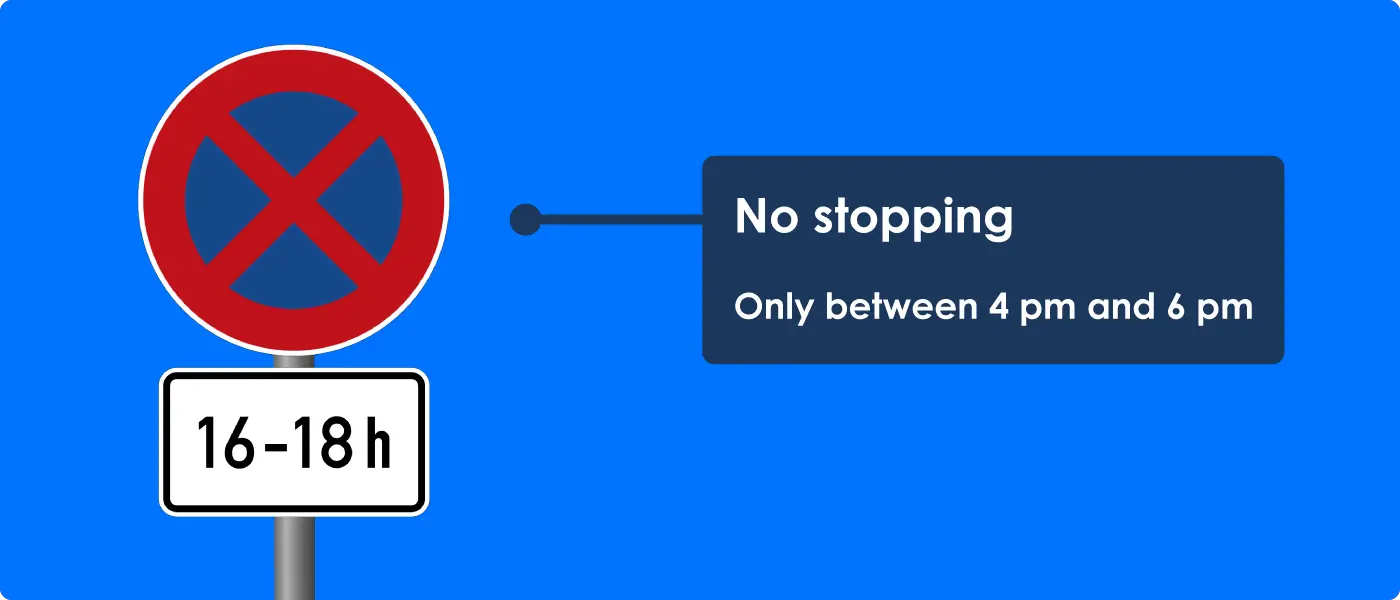
With a beginning, middle and end, an absolute ban on stopping on the right-hand side of the road, which only applies from 4 pm to 6 pm, looks like this:
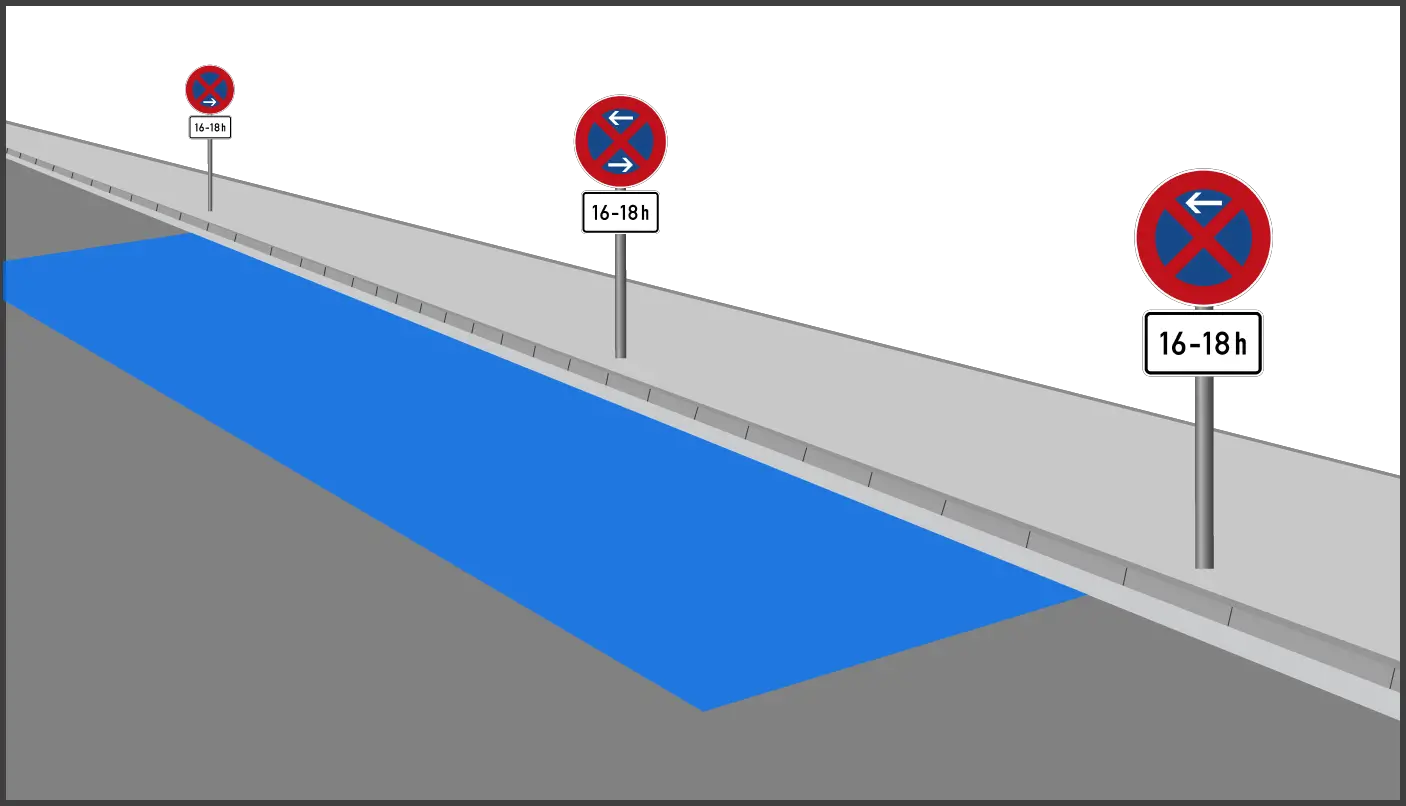
In the same way, No stopping can be limited to several periods of time.
In the illustration below, No stopping applies from 8 am to 11 am and from 4 pm to 6 pm.
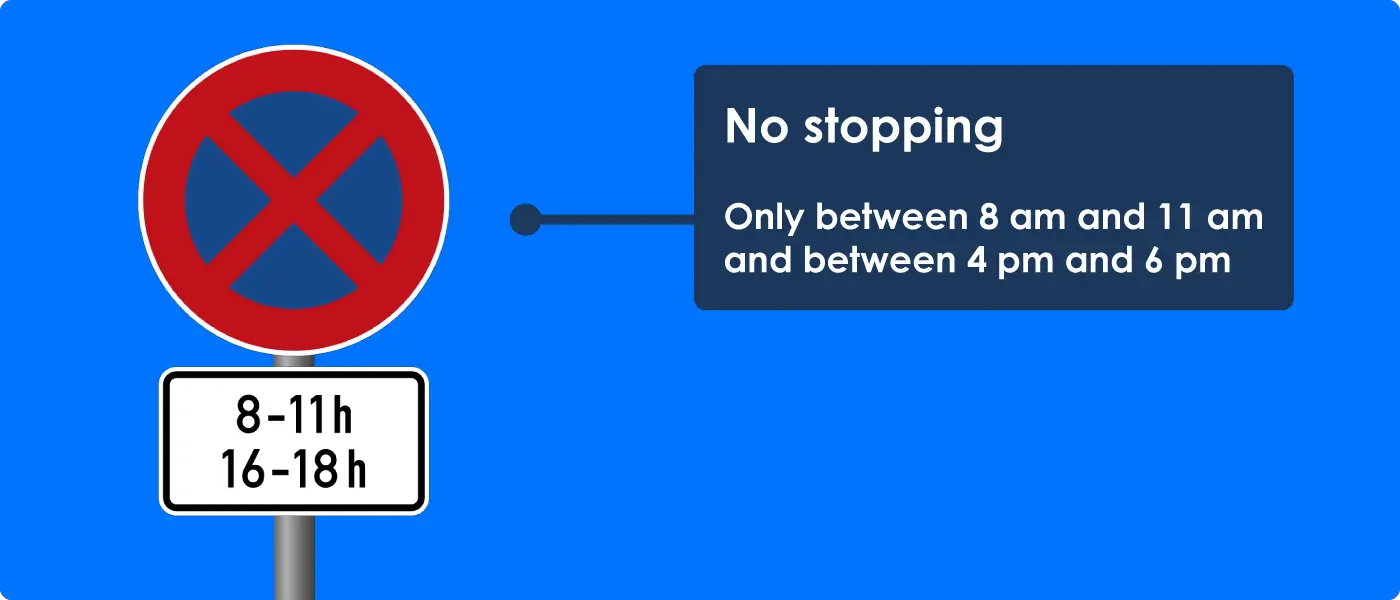
In everyday life, you will usually encounter No stopping with several periods on an additional sign with a beginning and an end:

However, it is also possible to limit No stopping from a certain point in time.
Below you can see No stopping, which only applies from 8 November at 6 pm.
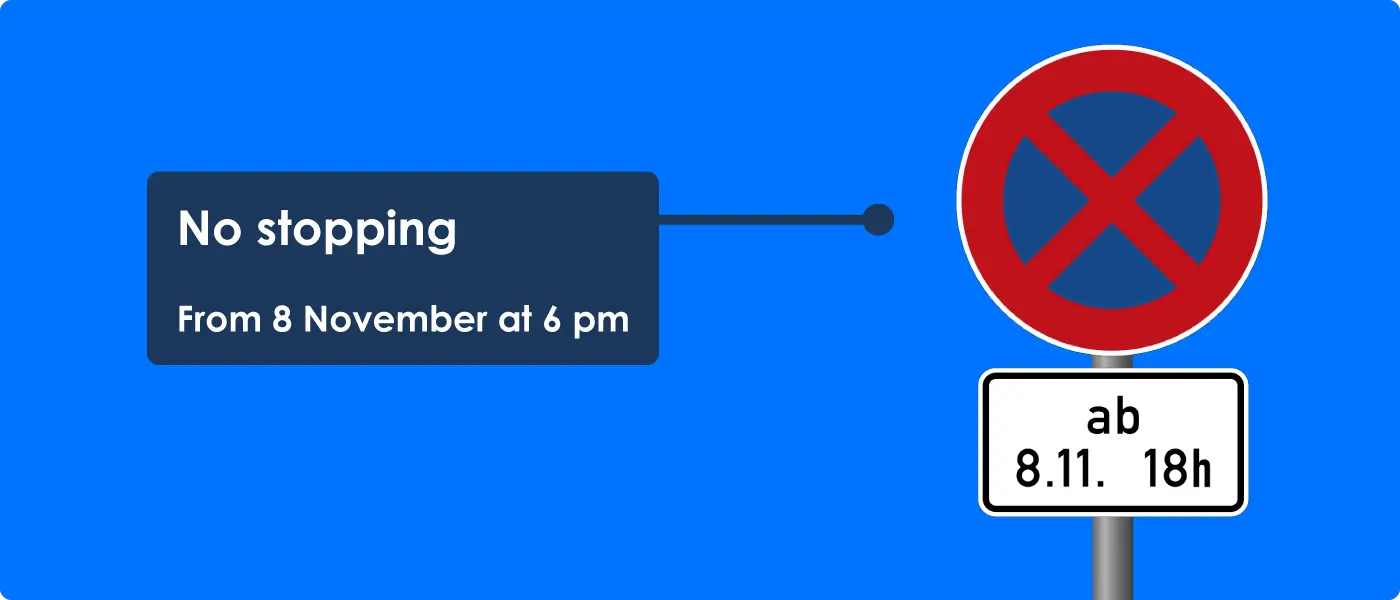
This is the case above all with No stopping, which is set up in anticipation of construction sites or moves.
For example, No stopping, which is installed before setting up a construction site, looks like this in practice:
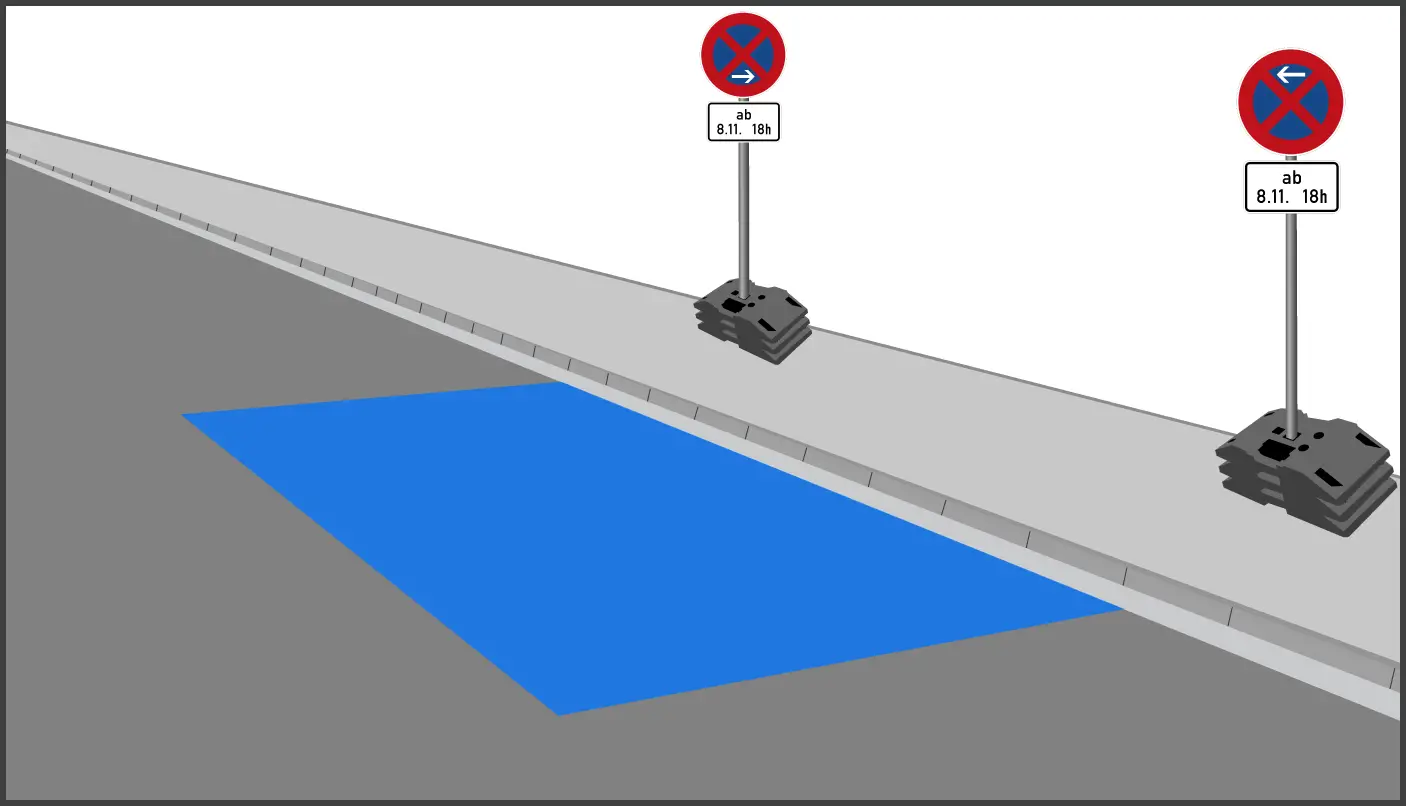
Other times may also appear on additional signs under No stopping.
No stopping with additional signs on which one or more times are indicated only apply at the times shown on the additional signs.
You can read more about the application, the approval, and the set-up of No stopping to carry out a move under the aforementioned link on this website.
No Stopping: Working Days
Some No stoppings are only valid on working days.
This is indicated by the combination of No stopping and the additional sign “werktags”.
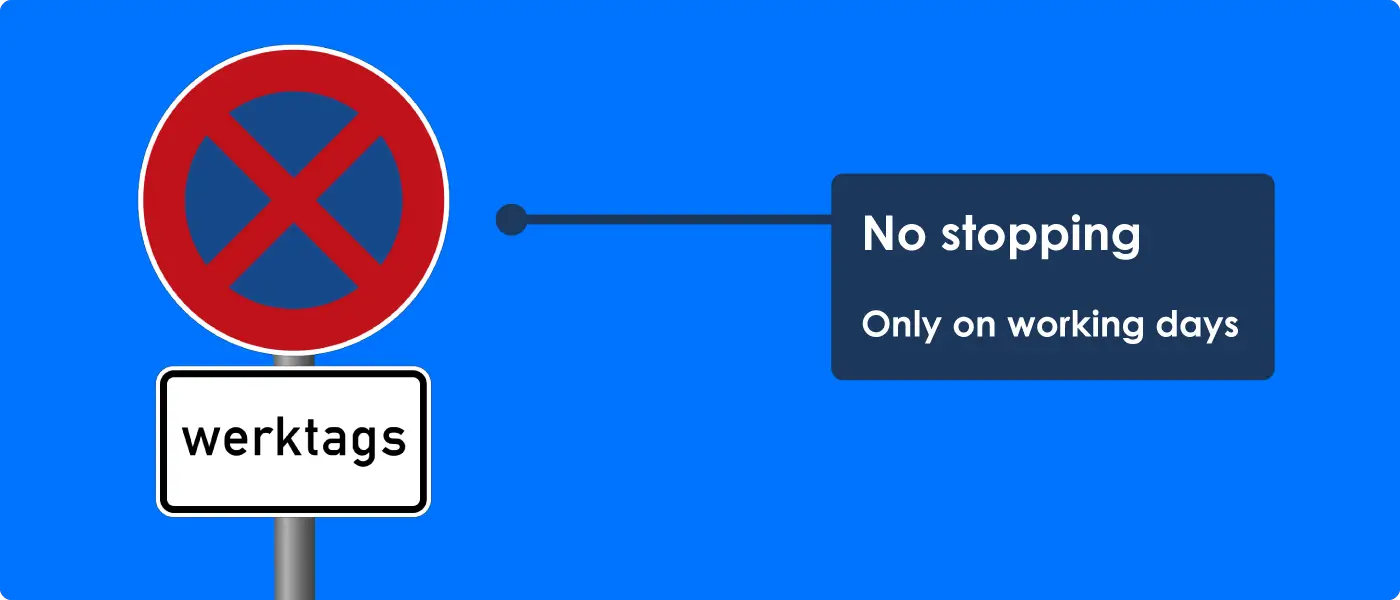
Sundays and public holidays are not working days.
Therefore, No stopping with the additional sign “werktags” apply from Monday to Saturday.
Why are Saturdays counted as working days?
According to settled case law, Saturdays are working days (OLG Hamburg, judgement of 16 February 1984 – 1 Ss 14/84 OWi; OLG Düsseldorf, judgement of 5 December 1990 – 2 Ss (OWi) 332/90 – 83/90 II; OLG Hamm, judgement of 07 March 2001 – 2 Ss OWi 127/01; BGH, judgment of 27 April 2005 – VIII ZR 206/04).
No stopping with the additional sign “werktags” do not apply on public holidays between Monday and Saturday.
A list of national holidays:
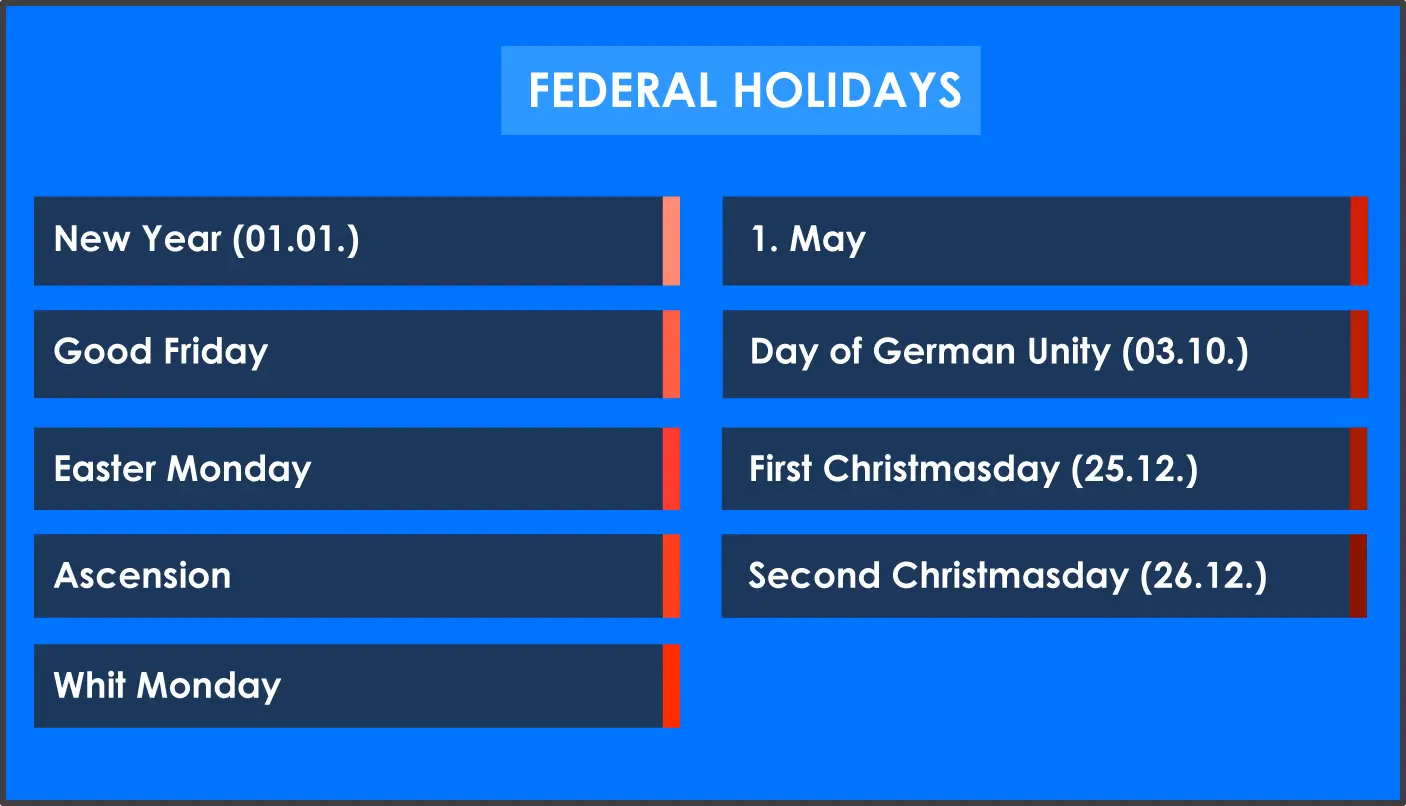
An example:
“Ascension Day” falls on a Friday. No stopping with the additional sign “werktags” do not apply on this Friday.
There are other public holidays. However, these are different for each state.
No Stopping: Weekdays With Time
With an additional sign under traffic sign 283, No stopping can also apply exclusively on “working days” at a specific time.
The No stopping below applies, for example, on working days from 6 pm to 7 pm.

The combination of No stopping with an additional sign with the inscription “werktags” and several times means that No stopping is limited to working days at the respective times.
Below you can see No stopping, which applies on workings days from 8.30 am to 11.30 am and from 4 pm to 6 pm.
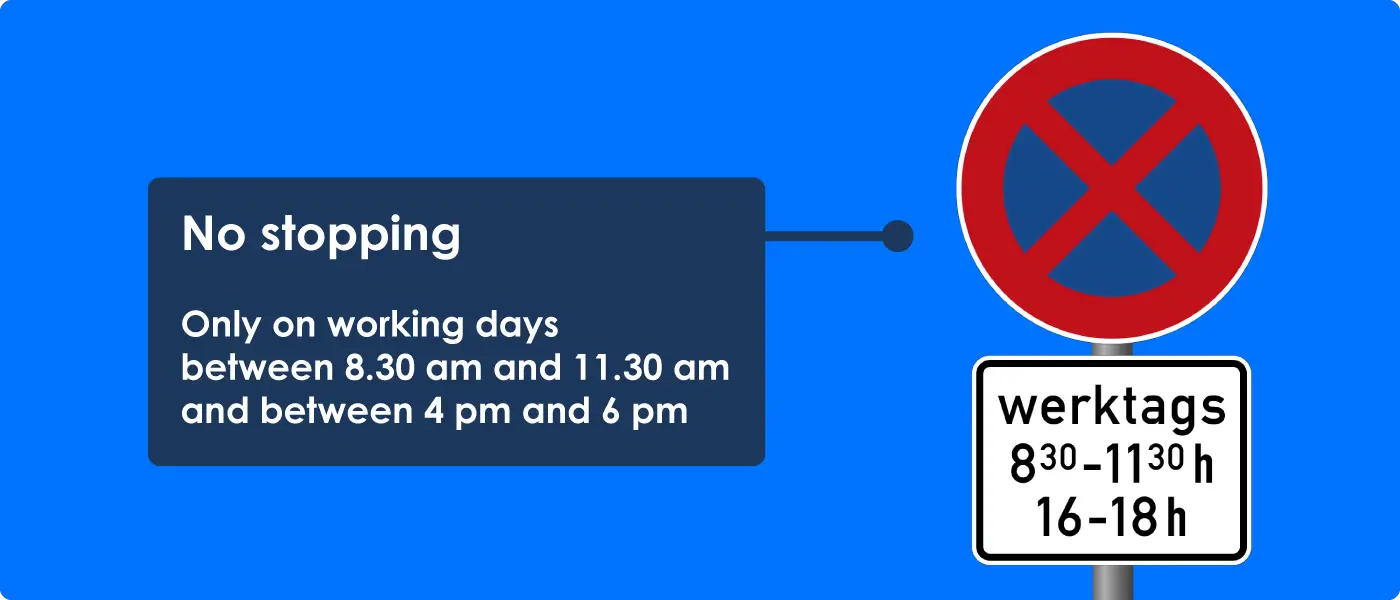
No Stopping: Working Days Except Saturdays
Occasionally you will also encounter No stopping, which are combined with the additional sign “werktags außer samstags”.
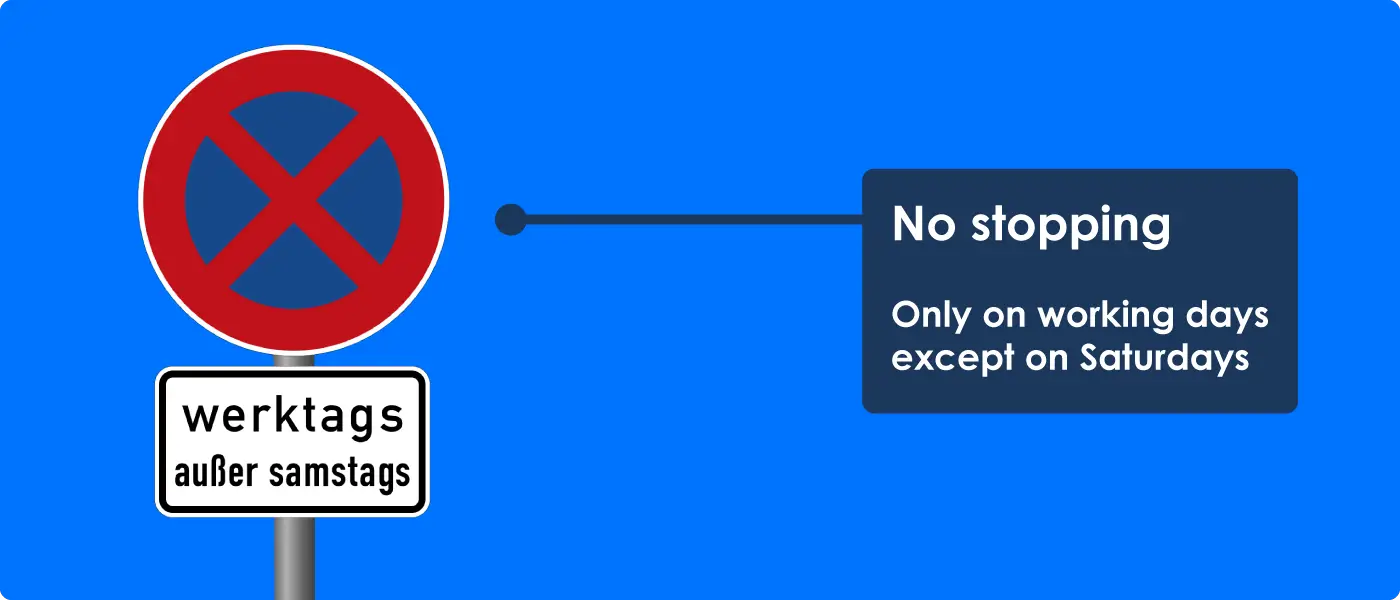
The additional sign “werktags außer samstags” allows stopping on Saturdays and Sundays.
No stopping with the addition “werktags außer samstags” apply on working days from Monday to Friday.
On public holidays in the period from Monday to Friday, it is therefore possible to stop in a No stopping section with the additional sign “werktags außer samstags”.
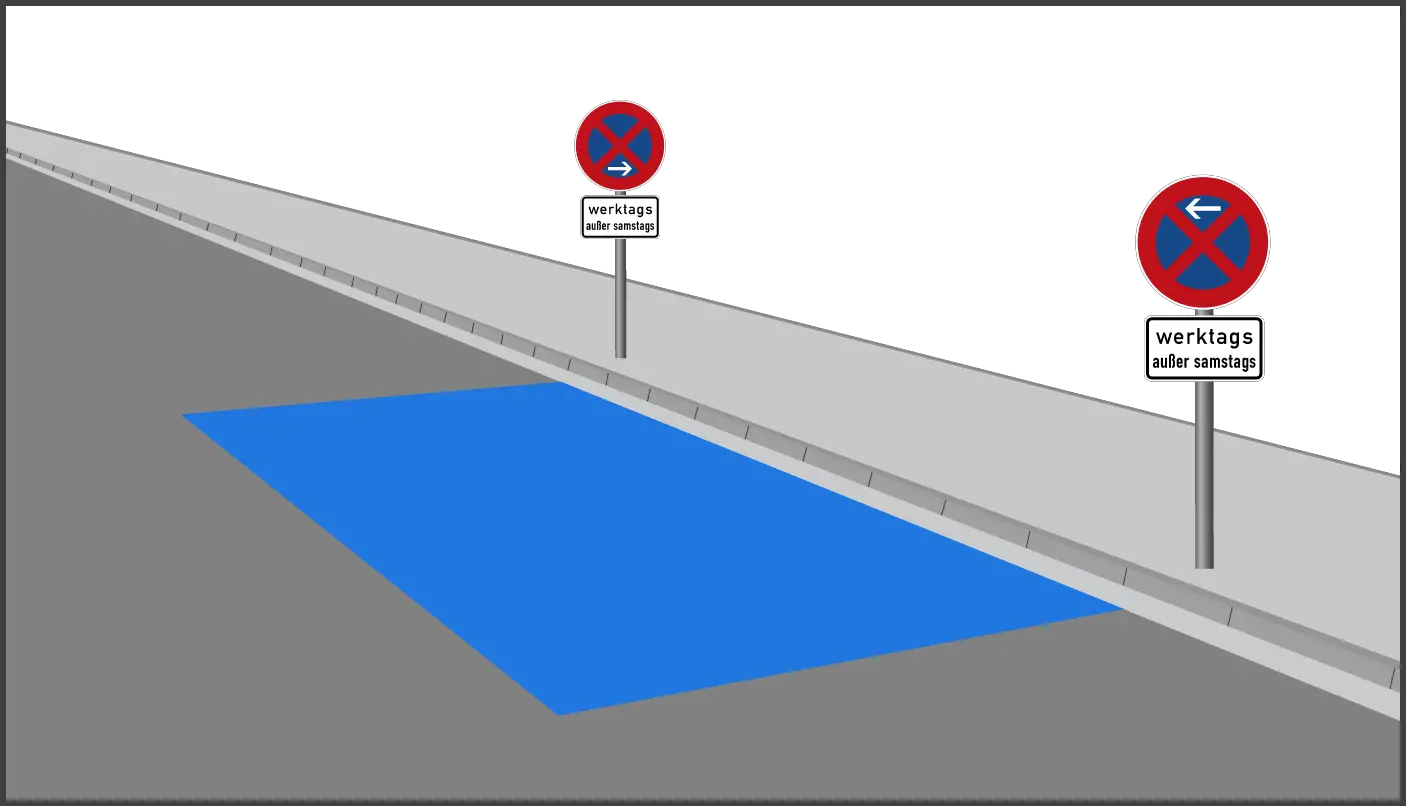
An example:
“Ascension Day” falls on a Wednesday. No stopping with the additional sign “werktags außer samstags” only apply on working days from Monday to Friday. However, the Wednesday mentioned above is a public holiday. According to this, it is allowed to stop on this Wednesday in an area signposted with traffic sign 283 and the additional sign “werktags außer samstags”.
No Stopping: Monday To Friday
No stopping can also apply from Monday to Friday.
For this purpose, the additional signs “Mo-Fr” are attached under the relevant traffic sign 283.
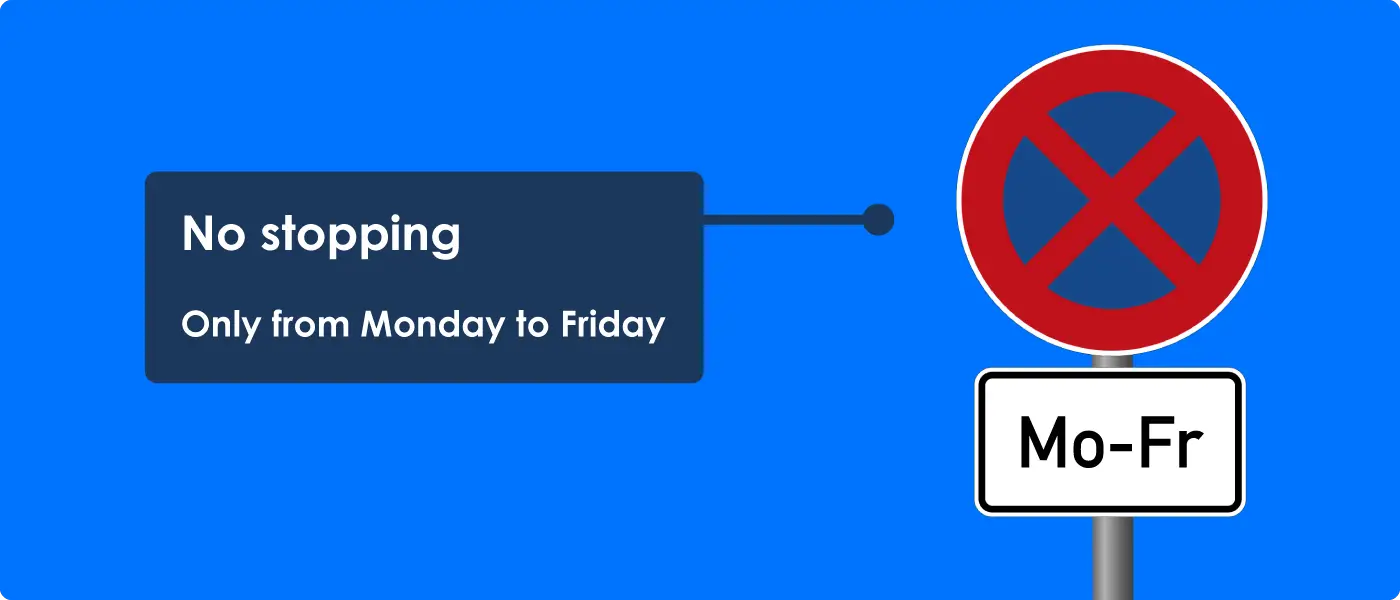
With the beginning, middle and end, No stopping on the right-hand side of the road with the additional sign “Mo-Fr” looks like this:
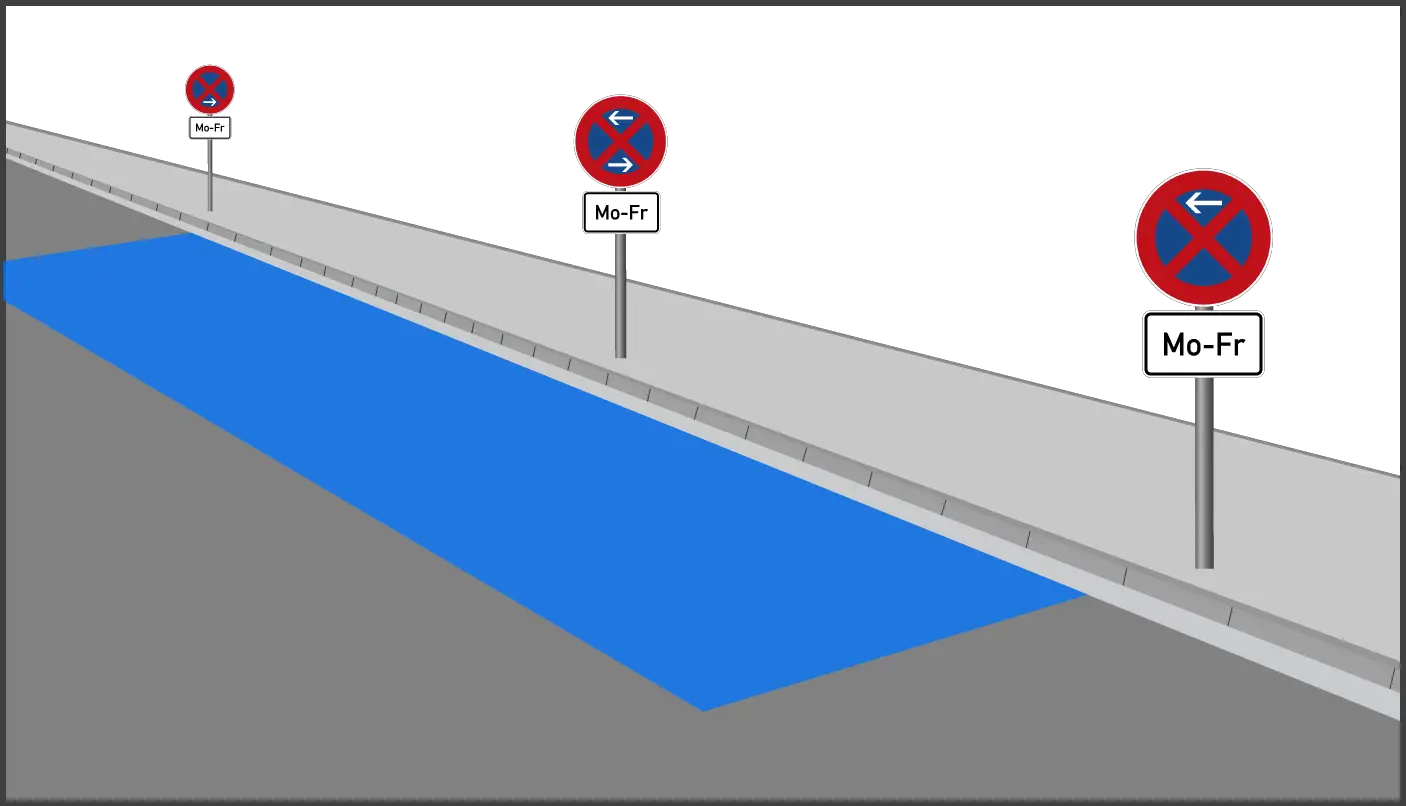
According to the judgement of the OLG Brandenburg, a speed limit with the additional sign “Mo-Fr” also applies to public holidays in the period from Monday to Friday (OLG Brandenburg, judgement of 28 Mai 2013 – (2 Z) 53 Ss-OWi 103/13 (50/ 13)).
In my opinion, No stopping with the additional sign “Mo-Fr” should also apply on public holidays in the period from Monday to Friday.
Furthermore, No stopping can be set up with an additional sign with the inscription “Mo-Fr” and a specific time.
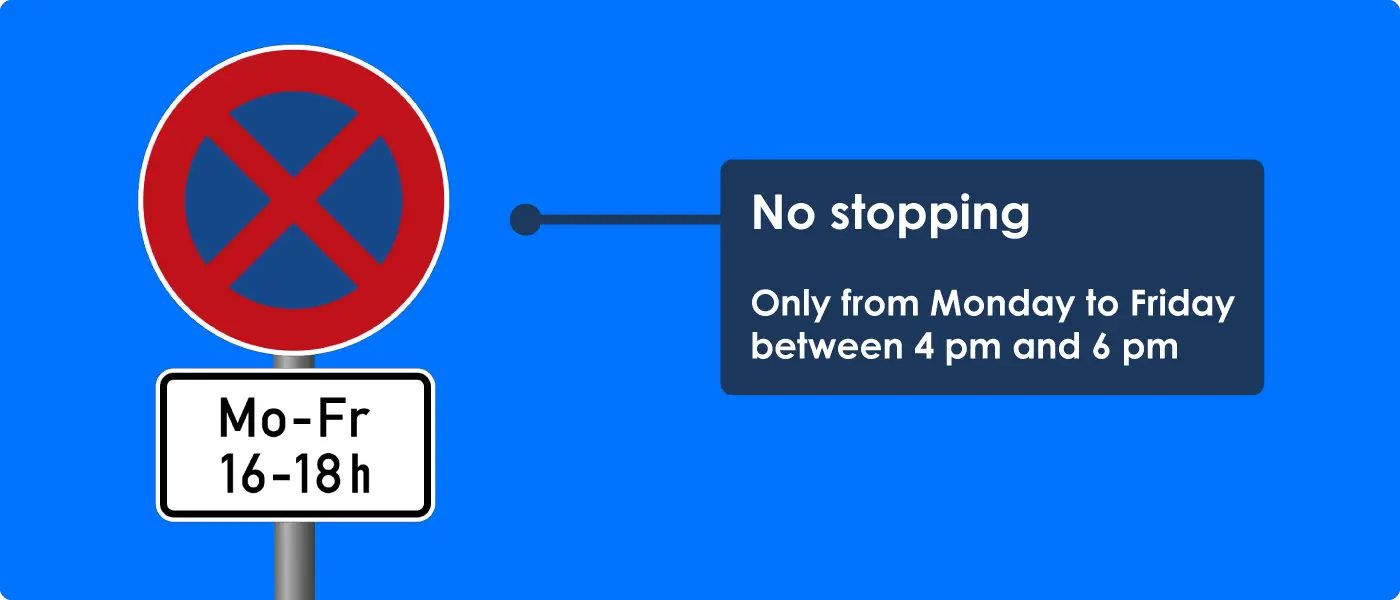
No stopping shown above applies from Monday to Friday – including public holidays – from 4 pm to 6 pm.
For clarification:
No stopping is valid on Mondays from 4 pm to 6 pm and on Tuesdays, Wednesdays, Thursdays and Fridays from 4 pm to 6 pm.
No stopping shown below applies from Monday to Friday from 7 am to 4 pm.
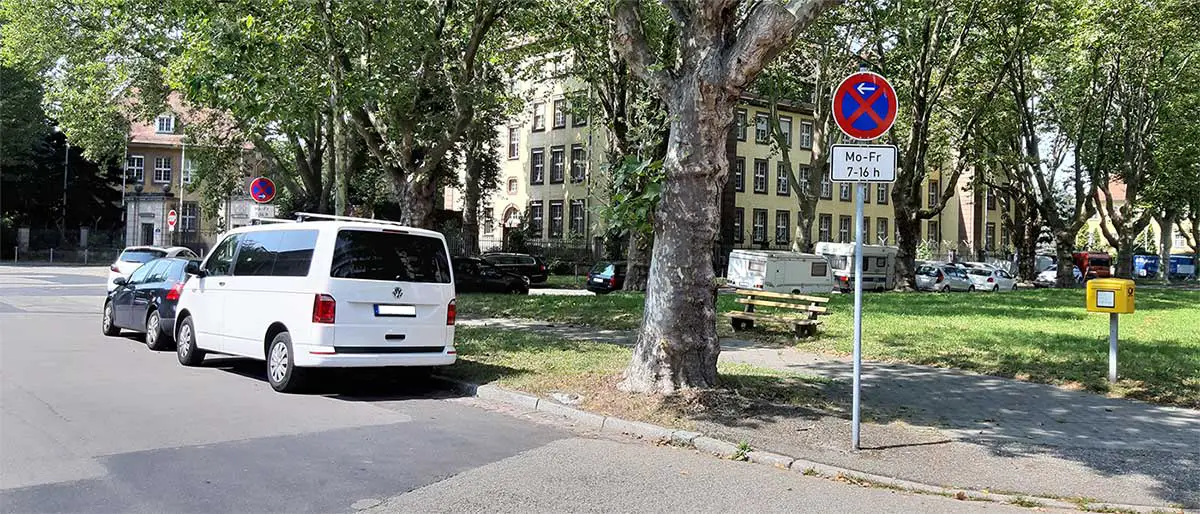
Outside the aforementioned period, stopping and parking in the designated area is permitted.
Stopping and parking is permitted on the area marked with traffic sign 283, for example, from Friday 4:01 pm to Monday 6:59 am.
The passenger cars shown above were compliant to rules parked on Saturdays.
No Stopping: Saturday, Sunday And Public Holidays
No stopping can only apply on weekends or on weekends and public holidays due to the combination with certain additional signs.
No stopping shown below is valid on Saturday and Sunday.
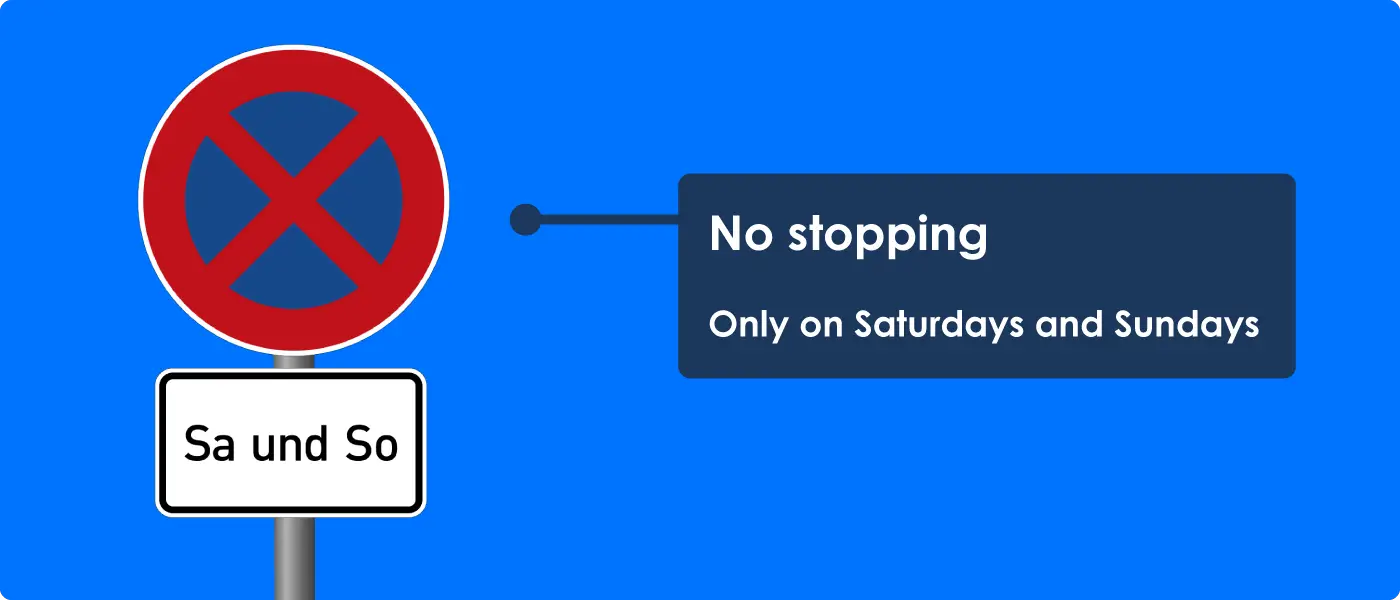
If a public holiday falls on a Saturday or Sunday, No stopping with the additional sign “Sa und So” must also be observed on Saturdays or Sundays.
Stopping is then not allowed in the area shown above, for example on a Saturday on which a public holiday falls.
Furthermore, No stopping can be restricted to Saturdays, Sundays and public holidays by combining No stopping with the additional sign “Sa, So und an Feiertagen”.
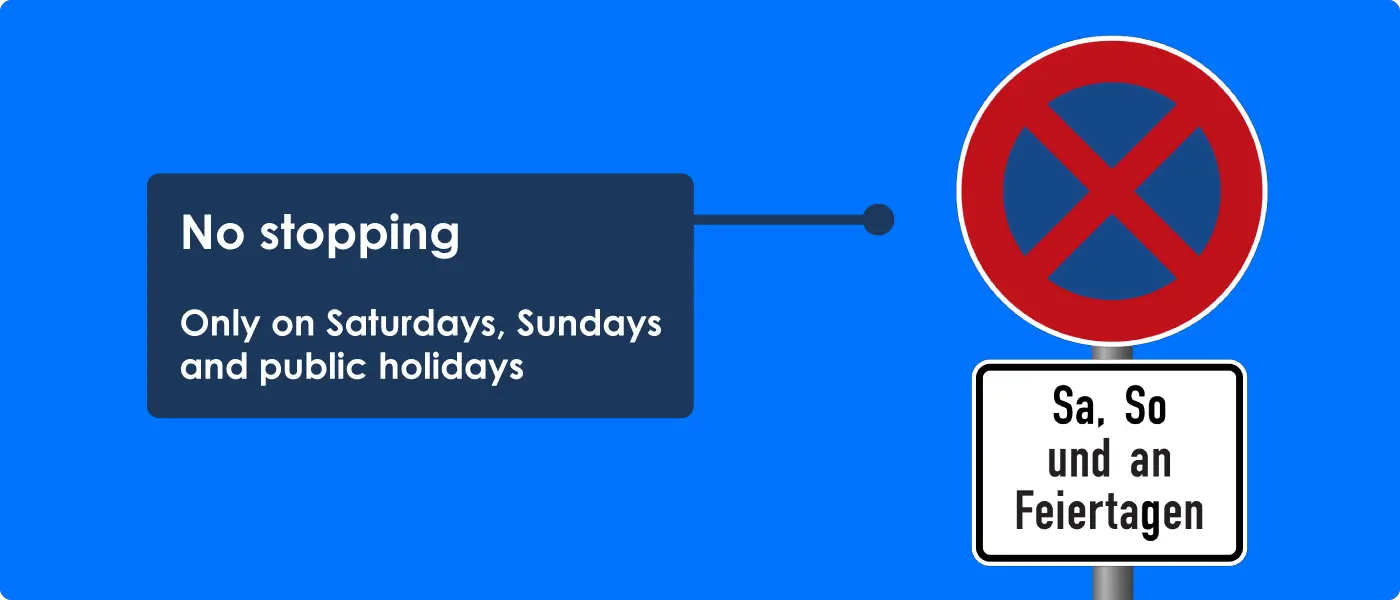
This means that No stopping not only applies on Saturdays and Sundays, but also on all public holidays from Monday to Friday.
No Stopping: Cars, Mobile Homes, Buses & More
If traffic signs 283 are combined with additional signs with symbols, No stopping applies only to the type of traffic shown on the additional sign.
I have put together some examples for you below:
- No Stopping Only For Motor Vehicles And Other Multi-Lane Vehicles
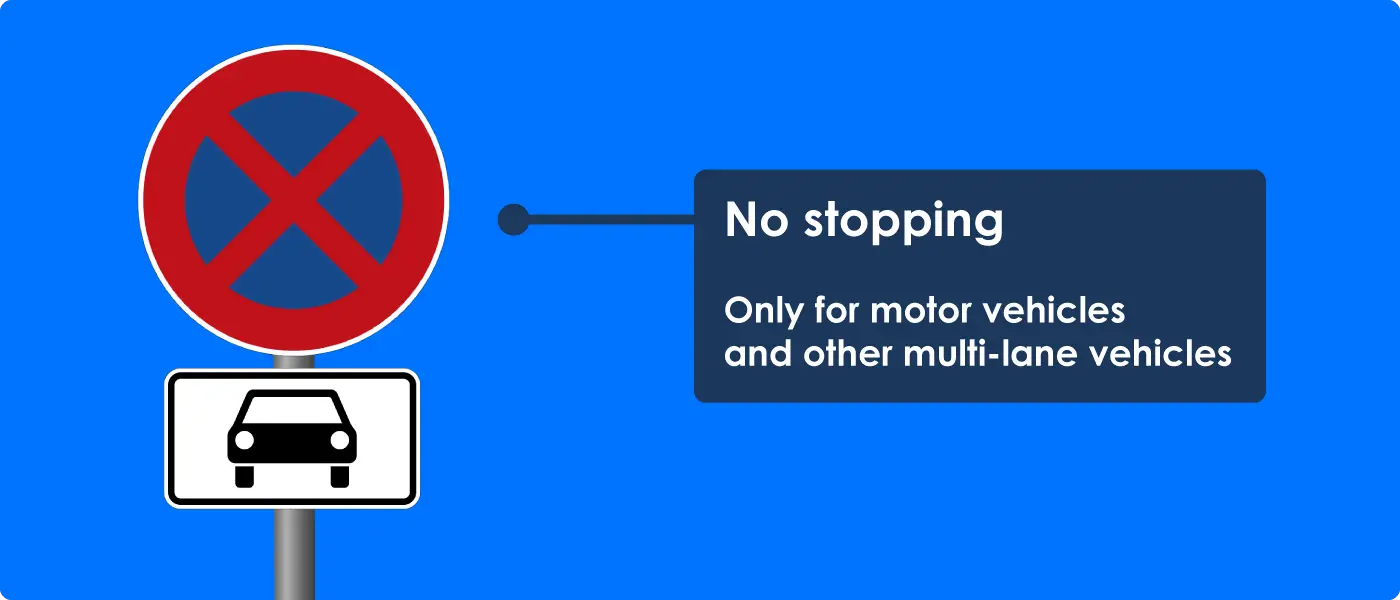
The symbol, which looks like a passenger car from the front, stands for motor vehicles and other multi-lane vehicles (section 39, paragraph 7 StVO).
Motorcycles, including those with sidecars, and mopeds are allowed to stop and park in No stopping areas with the additional sign “Kraftwagen und sonstige mehrspurige Fahrzeuge“.
You can read what is meant by motor vehicles in the article Meaning of Traffic Sign 260: Prohibition Of Motor Vehicles.
- No Stopping Only For Motor Vehicles With A Permissible Total Weight Of More Than 3.5 T
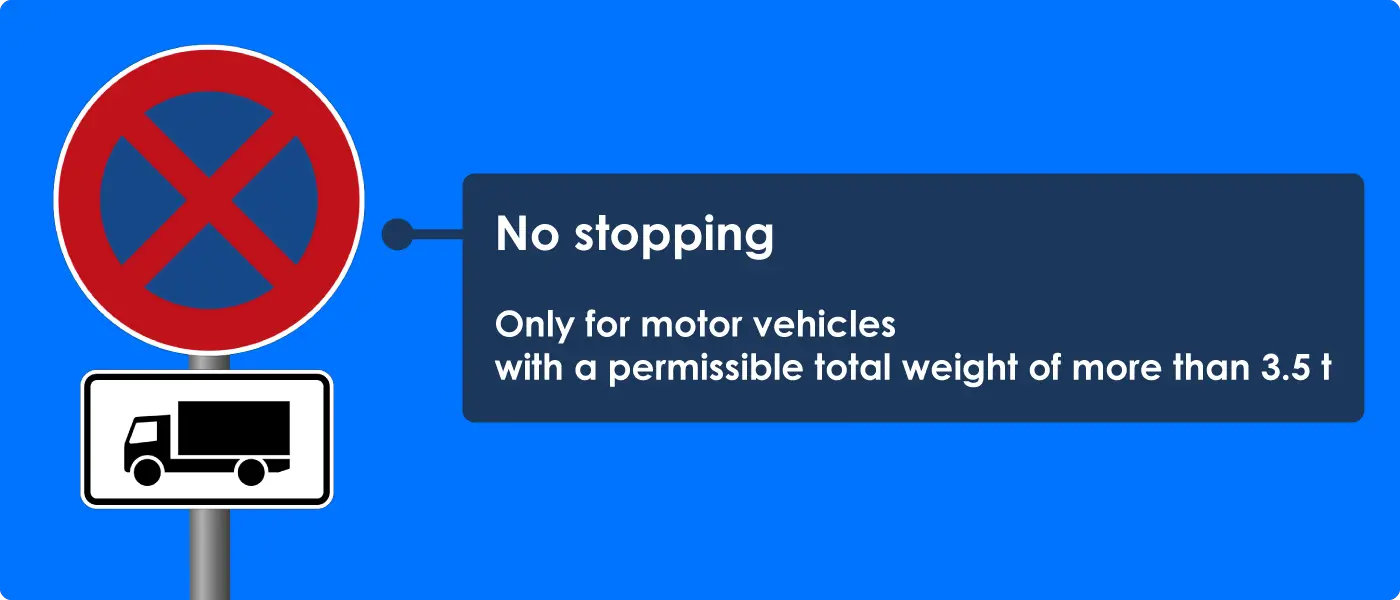
Motor vehicles with a permissible total mass of more than 3.5 t are commonly referred to as trucks or lorries.
The additional sign “Kraftfahrzeuge mit einer zulässigen Gesamtmasse über 3,5 t” also means motor vehicles including their trailers and tractors (section 39, paragraph 7 StVO).
Cars and buses are exempt from the additional sign “Kraftfahrzeuge mit einer zulässigen Gesamtmasse über 3,5 t” (section 39, paragraph 7 StVO).
Motorbikes, mopeds, passenger cars and buses are allowed to stop and park in No stopping areas with the additional sign “Kraftfahrzeuge mit einer zulässigen Gesamtmasse über 3,5 t“.
- No Stopping Only For Buses
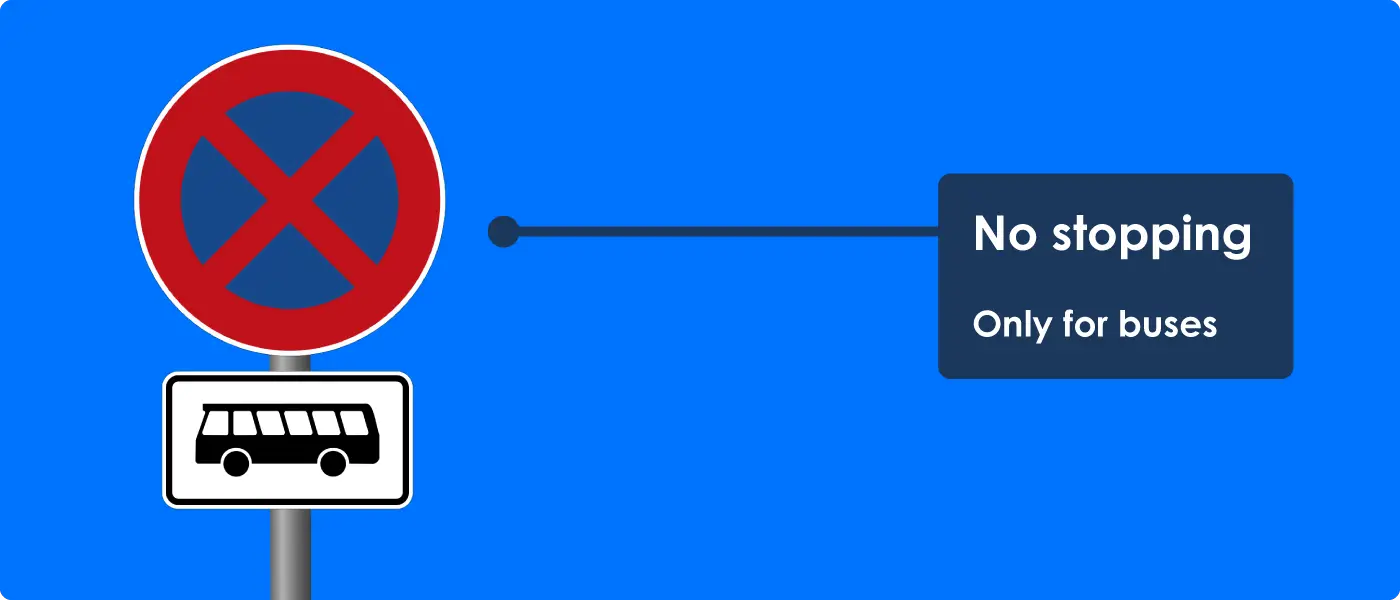
Motorbikes, mopeds, passenger cars and trucks are allowed to stop and park in No stopping areas with the additional sign “Kraftomnibusse“.
- No stopping Only For Passenger Cars
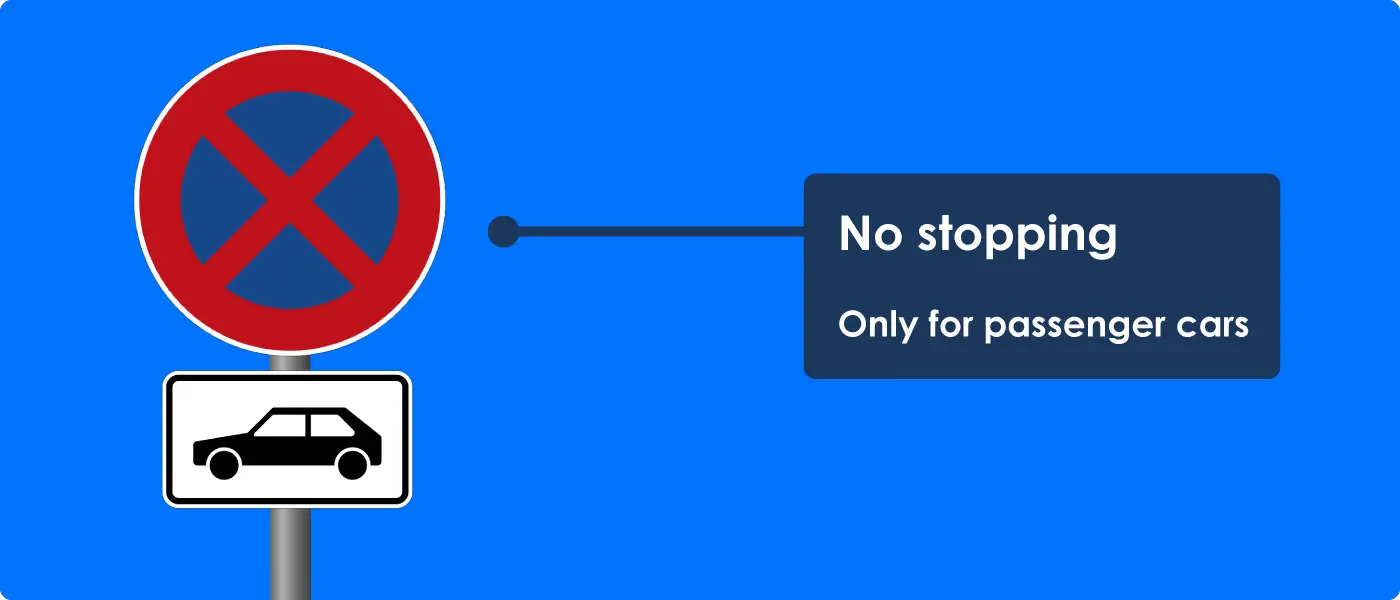
The symbol of a car from the side above stands for passenger cars (section 39, paragraph 7 StVO).
Motorbikes, mopeds, buses and trucks are allowed to stop and park in No stopping areas with the additional sign “Personenkraftwagen“.
- No Stopping Only For Passenger Cars With Trailers
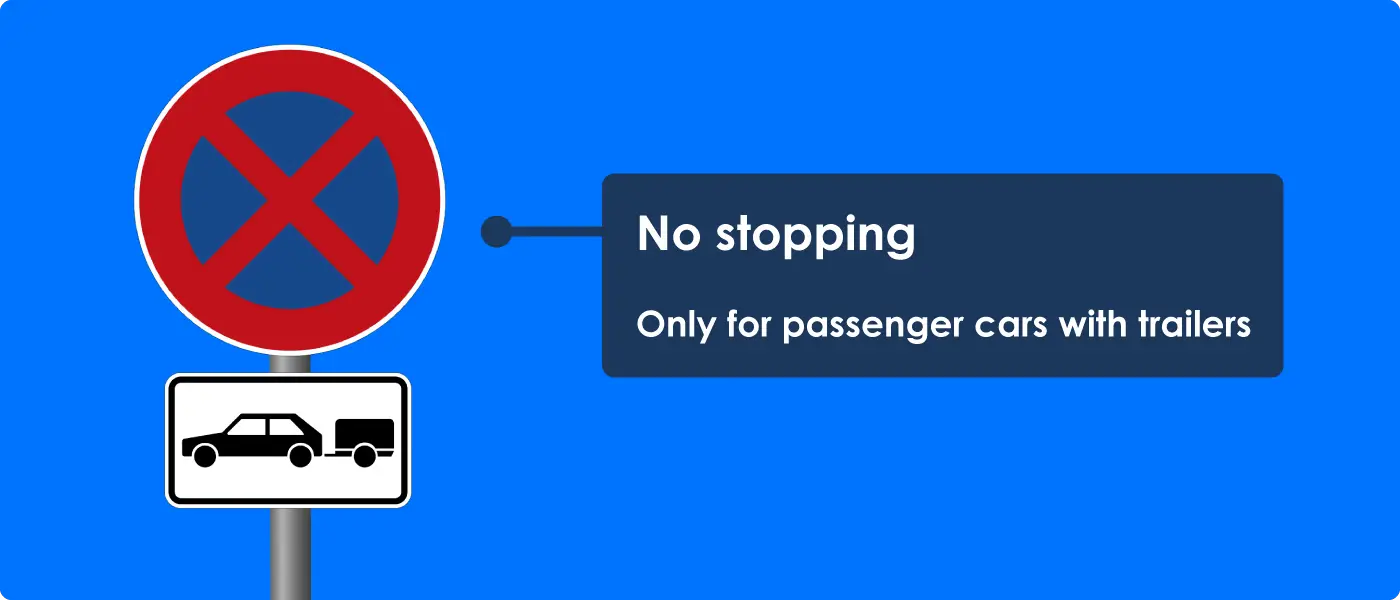
The symbol above stands for passenger cars with trailers (section 39, paragraph 7 StVO).
- No Stopping Only For Trucks With Trailers

The symbol above stands for trucks with trailers (section 39, paragraph 7 StVO).
- No Stopping Only For Motorcycles, Including Those With Sidecars, And Mopeds
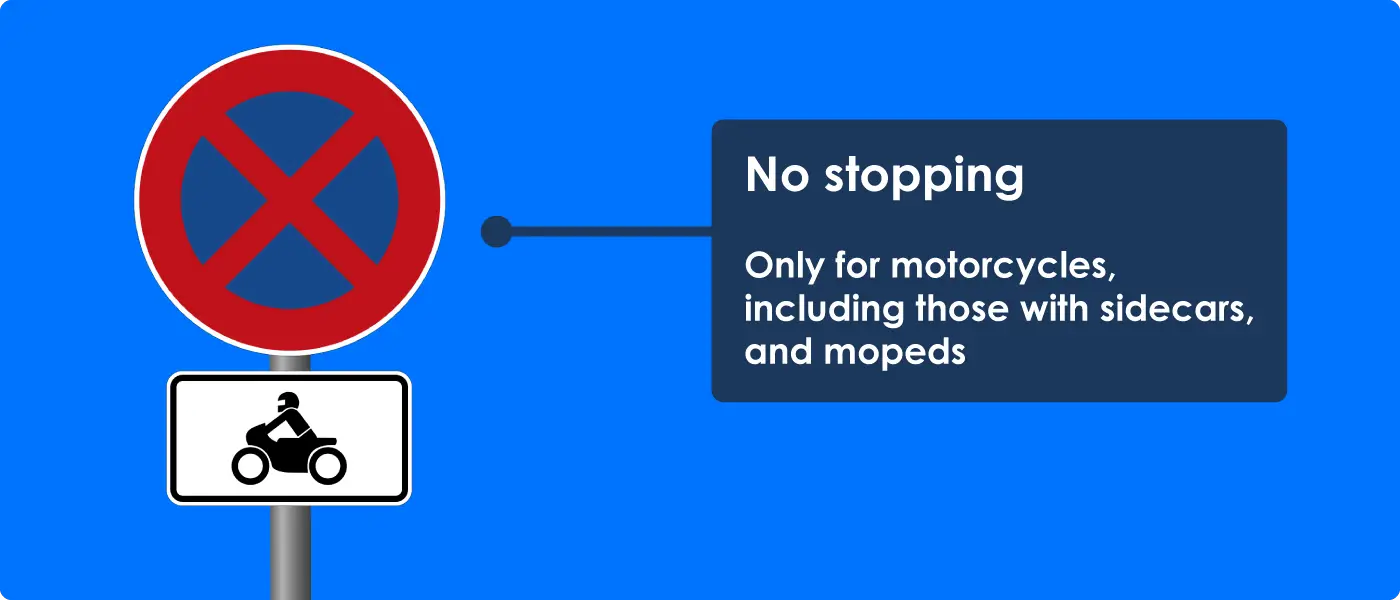
The symbol, on which a motorcycle and a motorcyclist are shown from the side, stands for motorcycles, also with sidecars, and mopeds (section 39, paragraph 7 StVO).
Passenger cars, buses and trucks are allowed to stop and park in No stopping areas with the additional sign “Krafträder, auch mit Beiwagen, Kleinkrafträder und Mofas“.
I answer what motorcycles and mopeds are in the article Meaning Of Traffic Sign 260: Prohibition for motor vehicles on this website.
- No Stopping Only For Mobile Homes
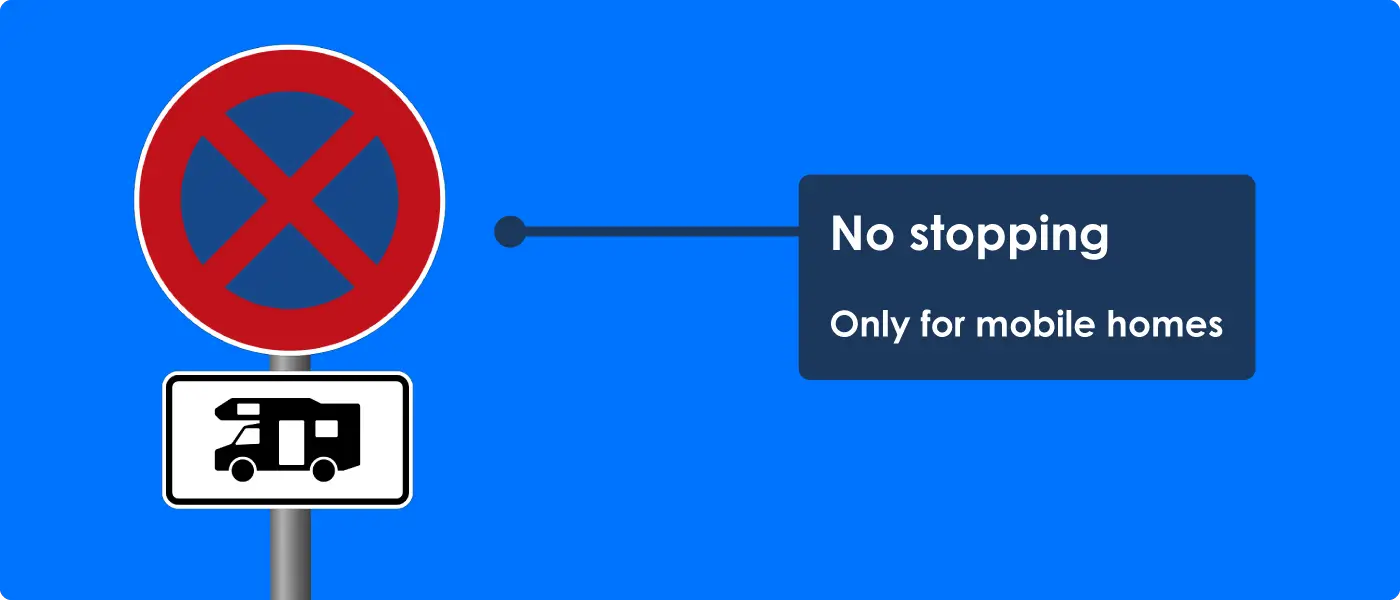
The symbol above stands for mobile homes (section 39, paragraph 7 StVO).
In the opinion of the Federal Government, the Higher Regional Court of Schleswig and the Court of Appeal in Berlin, mobile homes are not passenger cars (Bundestag printed paper 19/22803 of 24 September 2020 page 2; KG, judgement of 21 November 1991 – 2 Ss 127/91 – 3 Ws (B) 154/91; judgement of 12 December 1990 – 1 Ss OWi 413/90 ).
Passenger cars are therefore allowed to stop and park in No stopping areas with the additional sign “Wohnmobile”.
You can find out more about the difference between passenger cars and mobile homes in the Parking Signs In Germany Explained [+Additional traffic signs] section on this website.
- No Stopping Only For Semitrailers And Trucks With Trailers
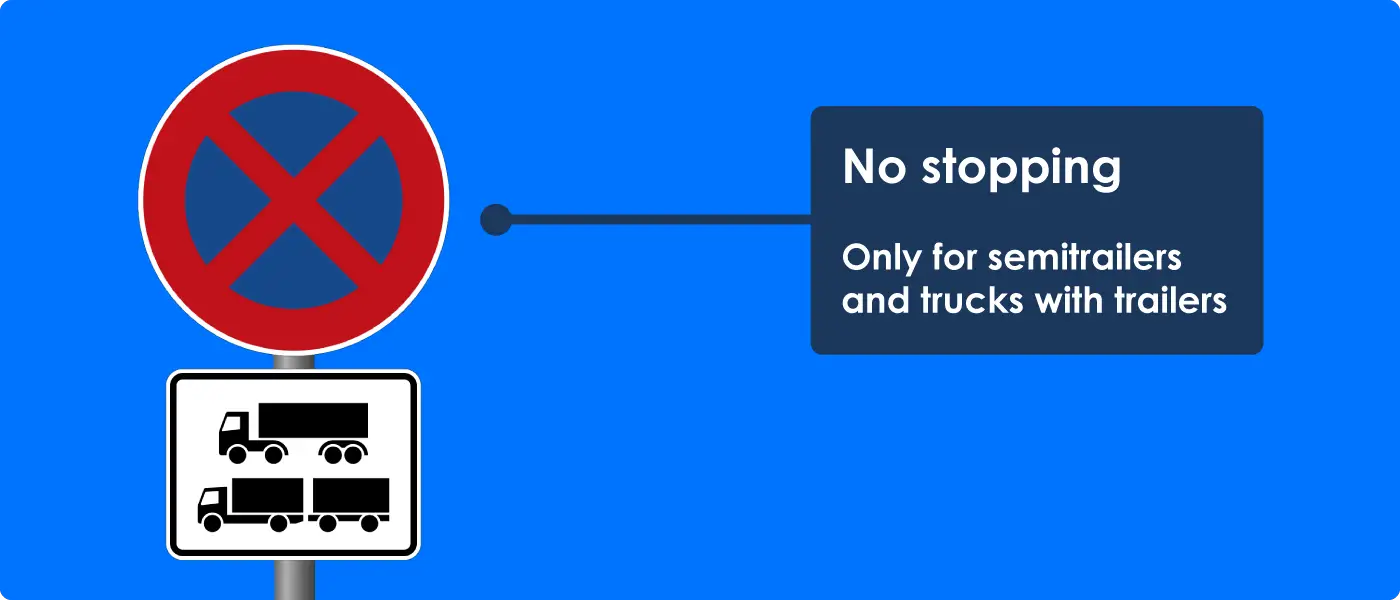
- No Stopping Only For Motor Vehicles With A Permissible Total Mass Of More Than 3.5 T, Buses And Passenger Cars With Trailers
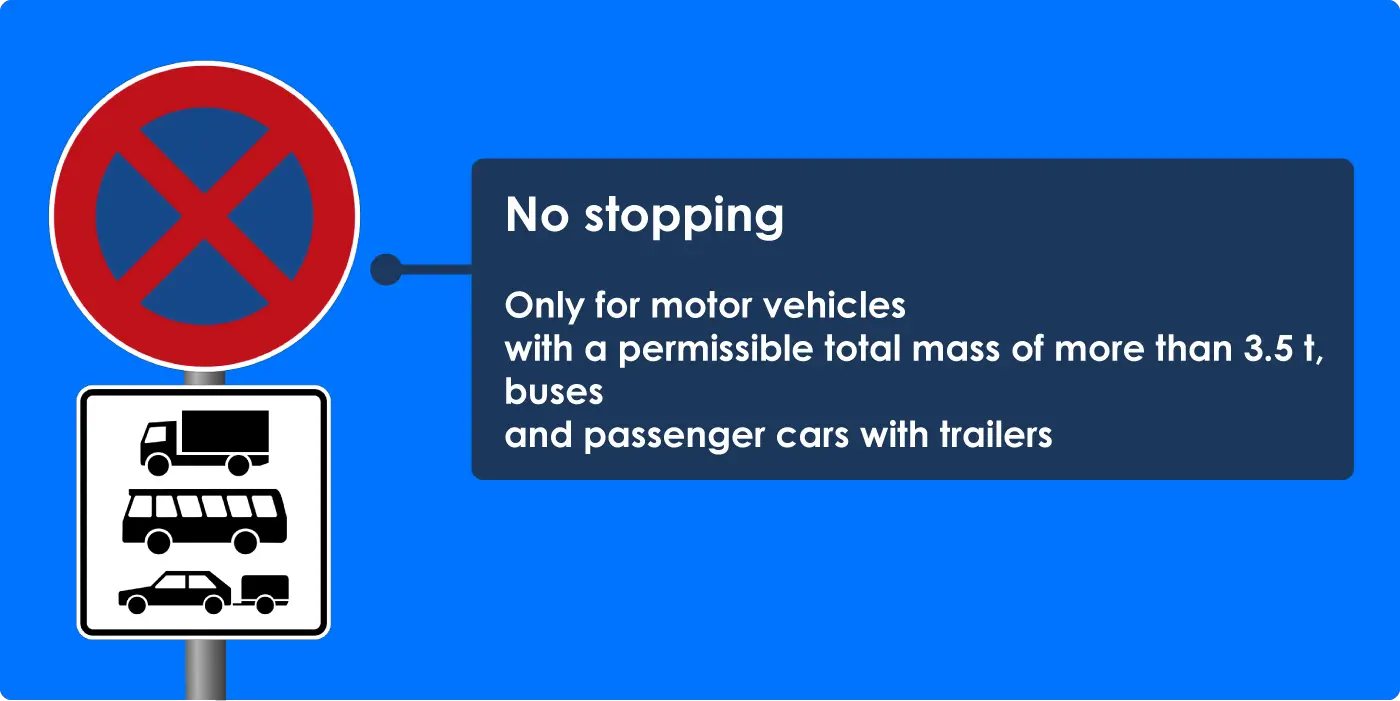
No Stopping: Passenger Cars Free
No stopping with the additional sign “Personenkraftwagen frei” prohibits all vehicles from stopping on the roadway, except for passenger cars.
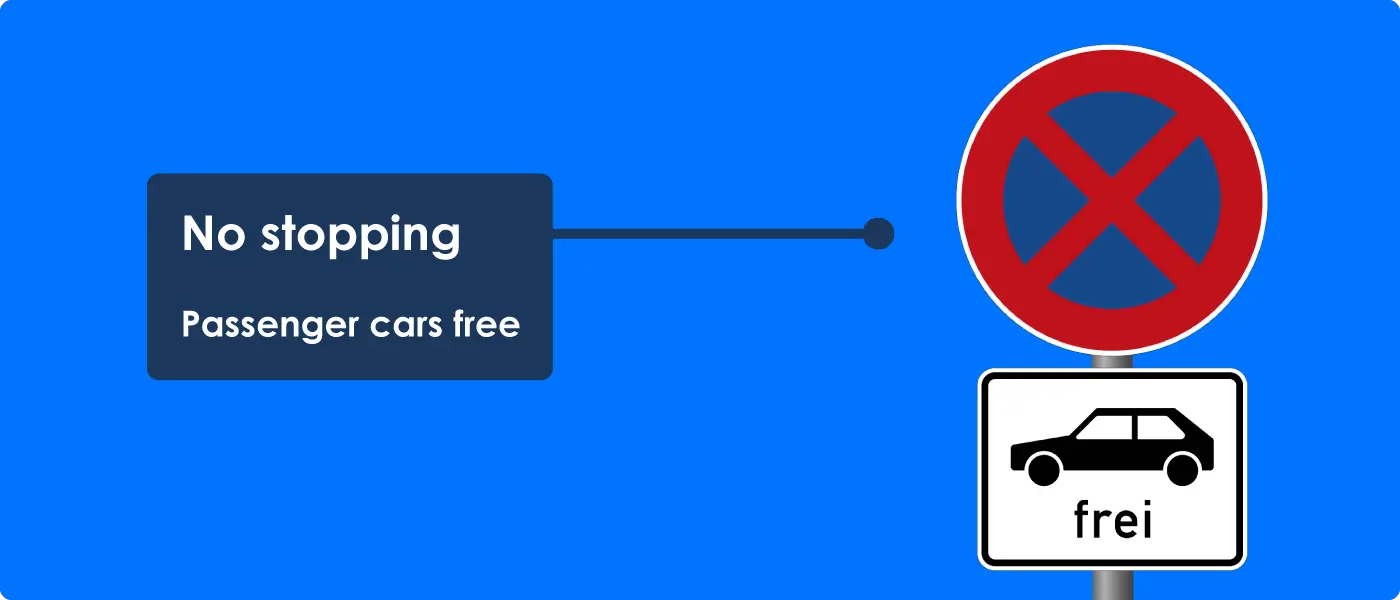
The symbol of a car from the side above stands for passenger cars (section 39, paragraph 7 StVO).
Accordingly, No stopping with the additional sign “Personenkraftwagen frei” applies for motorcycles, mopeds, buses and trucks.
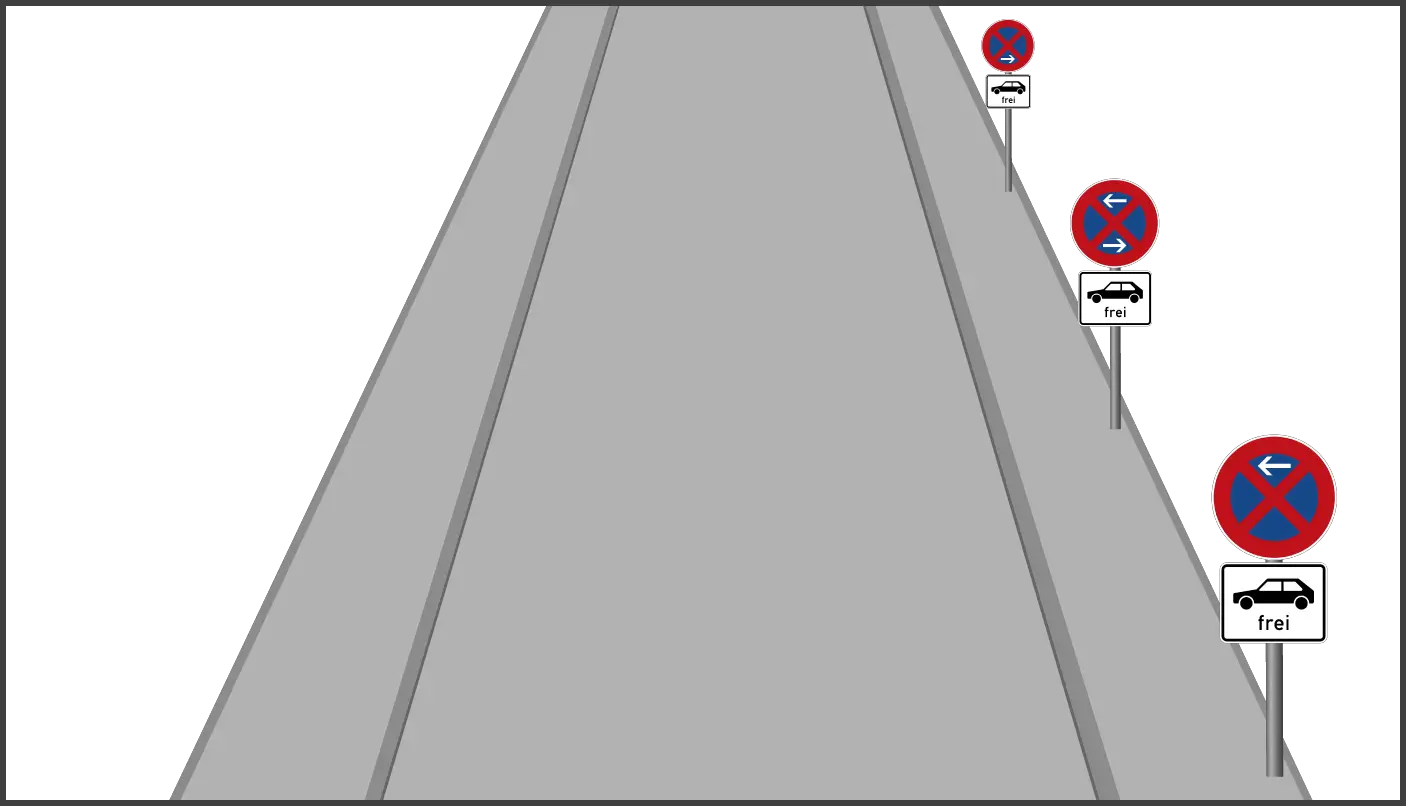
Motorbikes, mopeds, buses and trucks are not allowed to stop or park on the right-hand side of the roadway along No stopping areas shown above.
No Stopping: Severely Disabled & Residents Free
Can additional signs “Schwerbehinderte frei” and “Bewohner frei” be set up together with No stopping?
The Federal Administrative Court has commented on the recognizability of traffic signs for stationary traffic as follows:
If traffic signs are set up or attached in such a way that an average driver can see them ‘with a quick and casual glance’ if he observes the due diligence required according to section 1 StVO […], they express their legal effect after the so-called [sic!] principle of visibility, vis-à-vis every road user affected by the regulation.
BVerwG, judgement of 06 April 2016 – 3 C 10.15, marginal number 16
One could therefore take the view that additional signs “Schwerbehinderte frei” and “Bewohner frei” can also be set up together with traffic sign 283.
It is easy to see which prohibition is based on No stopping that is combined with additional signs “Schwerbehinderte frei” and “Bewohner frei”.
Traffic sign 283 with the additional sign “Schwerbehinderte frei” excludes severely disabled people
- with exceptional walking disabilities,
- bilateral amelie
- or phocomelia
- or with comparable functional limitations
- as well as blind people
each with the corresponding parking permit number, from No stopping.
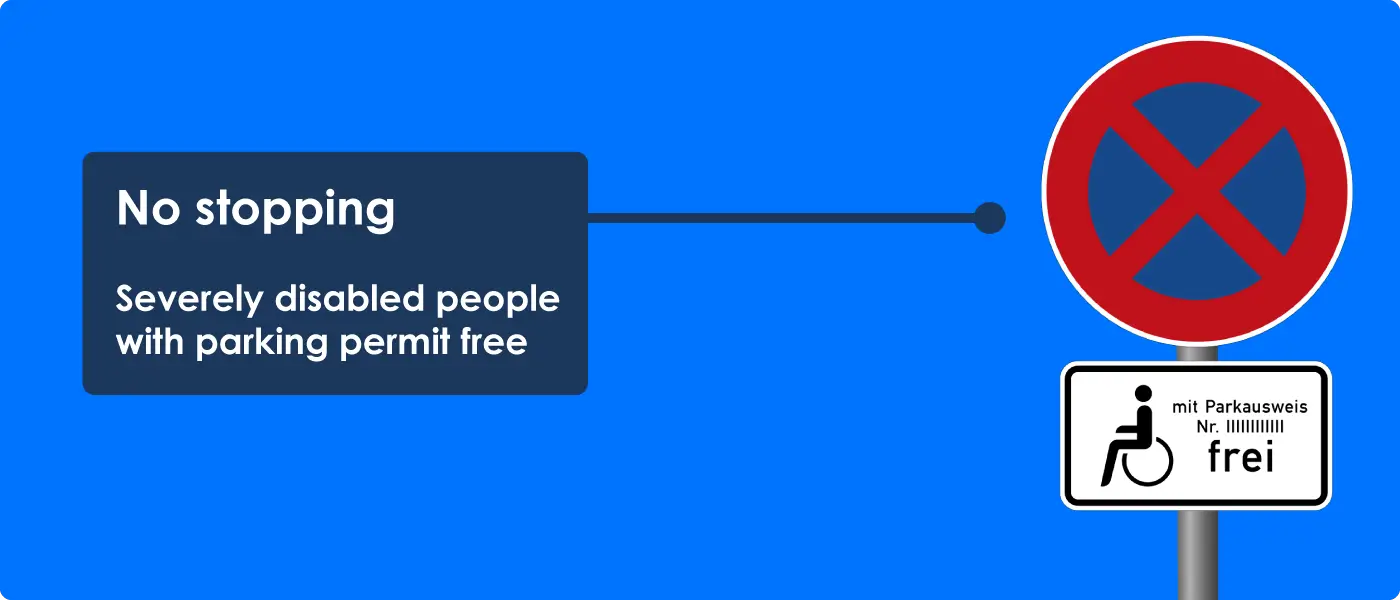
All other vehicle drivers without a corresponding parking permit are not allowed to stop in No stopping areas with the additional sign “Schwerbehinderte frei”.
No stopping with the additional sign “Bewohner frei” allow residents with a special parking permit to stop along the marked No stopping areas.
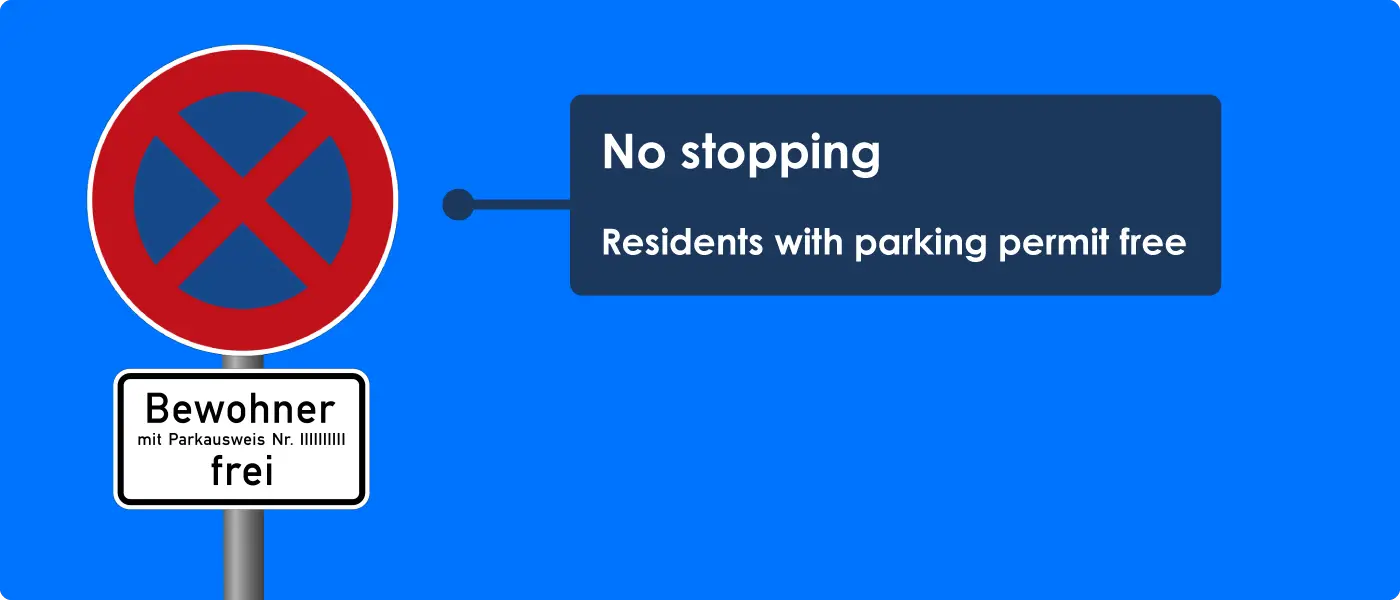
Only residents with the correct parking permit number are allowed to park in No stopping areas with the additional sign “Bewohner frei”.
However, traffic sign 283 represents No stopping. Traffic sign 283 isn’t about parking, it’s about stopping.
Furthermore, the additional signs “Schwerbehinderte frei” and “Bewohner frei” are only mentioned under No waiting (Annex 2 consecutive number 63.3-63.4 StVO).
In my opinion, the aforementioned additional signs are not intended for use in combination with No stopping.
In any case, it must be justified on the basis of the individual case why No stopping is necessary at the corresponding point and why one of the groups of people or types of traffic mentioned above is exempt from traffic sign 283 (section 45, paragraph 9 StVO).
No Stopping: Electric Cars free
The additional sign “E-Auto frei” is only mentioned under No waiting (Annex 2 consecutive number 63.5 StVO).
The combination of traffic sign 283 with the additional sign “E-Auto frei” is therefore not provided for by the road traffic regulations.
In my opinion, with the additional signs “E-Auto frei” and “Carsharing frei” under traffic sign 283, road users can also “take a quick and casual look” at how they have to behave in this case.

The additional sign “E-Auto frei” exempts electrically powered vehicles from No stopping within the meaning of EmoG.
What are electrically powered vehicles within the meaning of EmoG?
Electrically powered vehicles within the meaning of the EmoG are vehicles with an E licence plate (section 39, paragraph 10 StVO, section 9a, paragraph 2, 4 and 5 FZV).
No Stopping: Car Sharing free
The additional sign “Carsharing frei” is only used under No waiting (Annex 2 consecutive number 63.6 StVO).
This also suggests that the additional sign “Carsharing frei” was not introduced into the road traffic regulations for attachment under No stopping.
What does No stopping with the additional sign “Carsharing frei” mean?
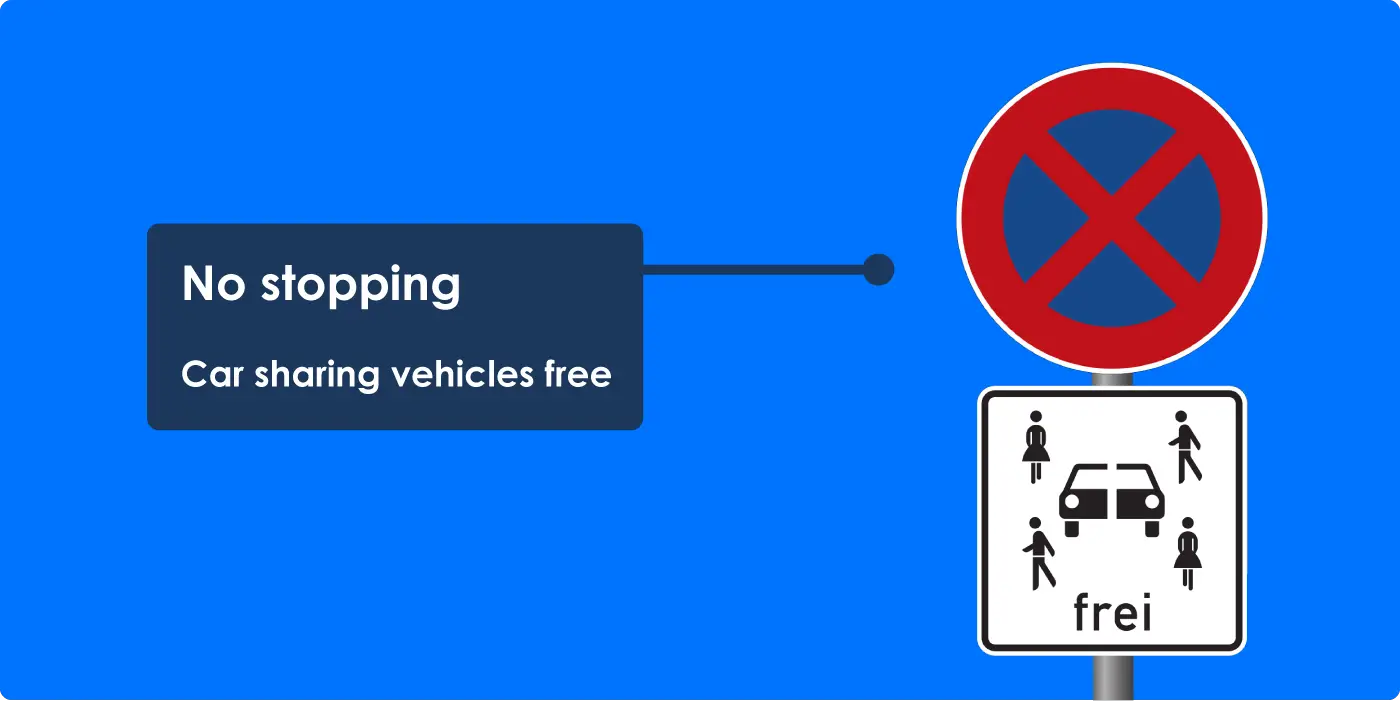
The passenger car divided in the middle with the four figures is a symbol for car sharing (section 39, paragraph 11 StVO).
No stopping with the additional sign “Carsharing frei” prohibits stopping on the roadway. Car sharing vehicles are excluded.
Car sharing vehicles are therefore allowed to stop and park in No stopping areas with the additional sign “Carsharing frei”.
Summary
Hard shoulders, like parking lanes, are located next to the roadway.
Traffic sign 283 can be restricted to a specific time or specific days of the week using additional signs. One or more periods of time can be indicated on additional signs under No stopping.
No stopping are limited to passenger cars, mobile homes or buses with additional signs with symbols.
The Road Traffic Regulations do not provide for the additional signs “Schwerbehinderte Menschen frei”, “Bewohner frei”, “E-Auto frei” und “Carsharing frei” under No stopping, but under No waiting.
Have you discovered an additional sign under No stopping that is not yet part of this article?
Did you like this article?

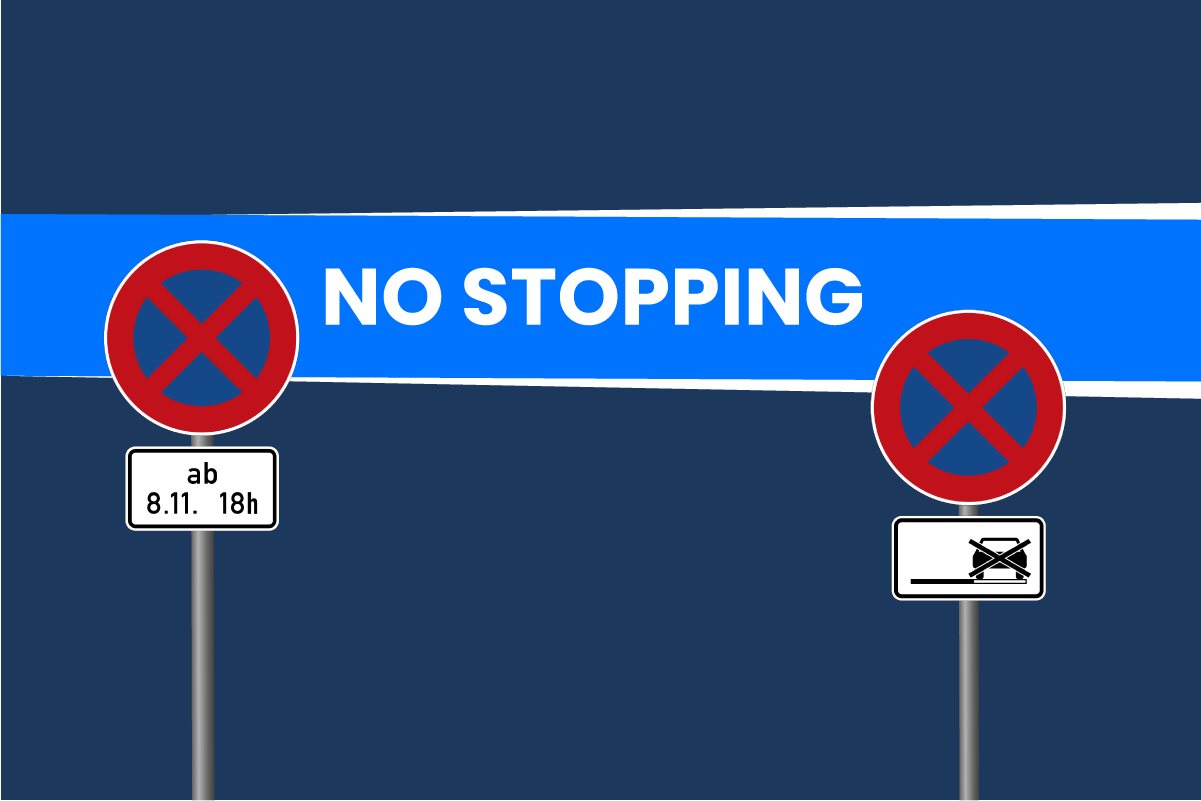

![Parking Signs In Germany Explained [+Additional Traffic Signs]](https://www.stvo2go.de/wp-content/uploads/parken-zusatzzeichen-english-768x513.png)
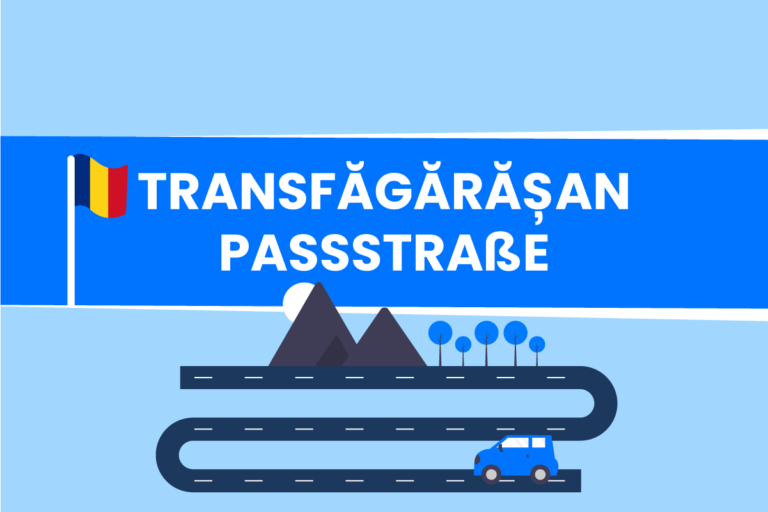

![Parkverbote in Frankreich erklärt [mit Bildern]](https://www.stvo2go.de/wp-content/uploads/parkverbote-frankreich-thumbnail-768x512.png)
